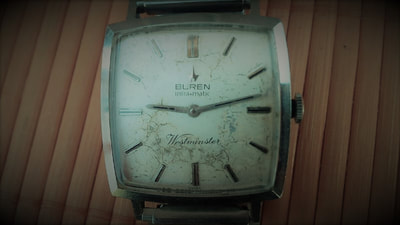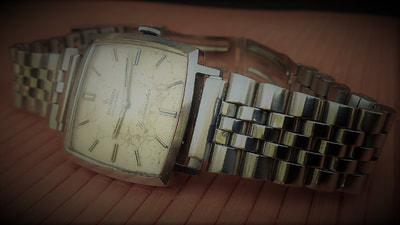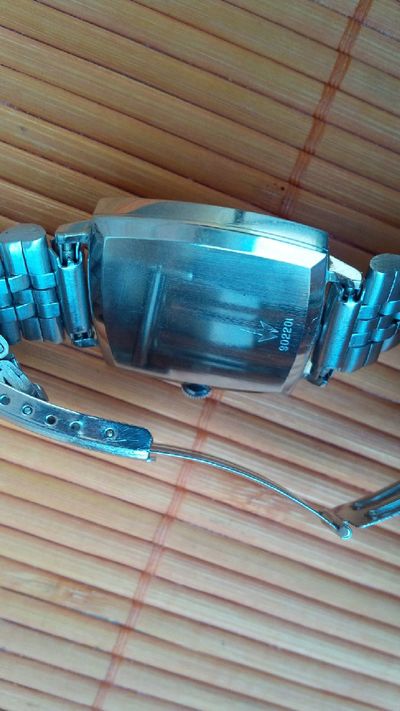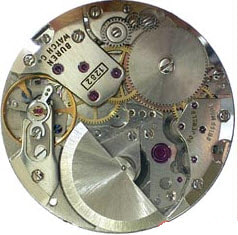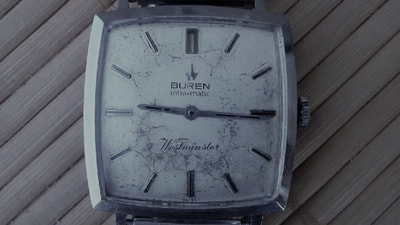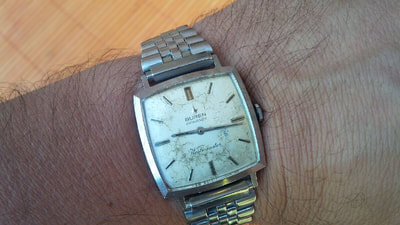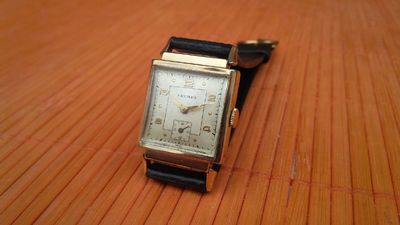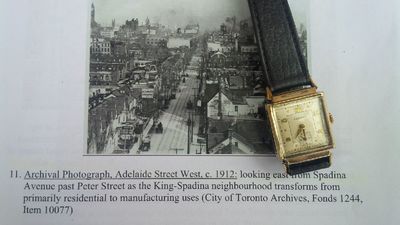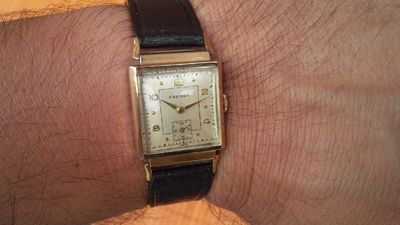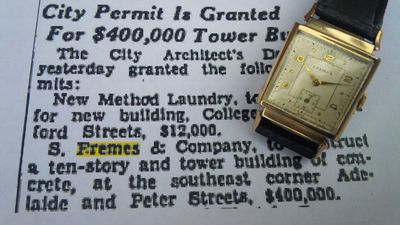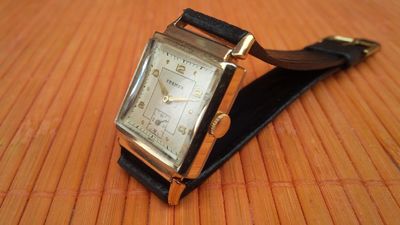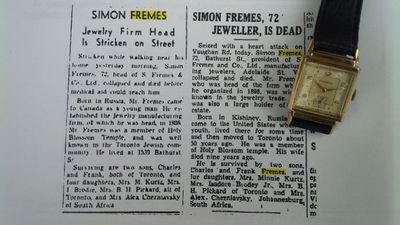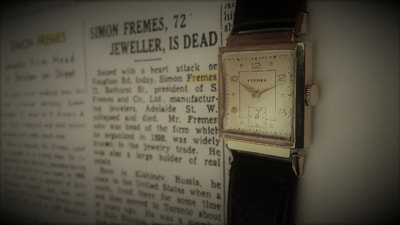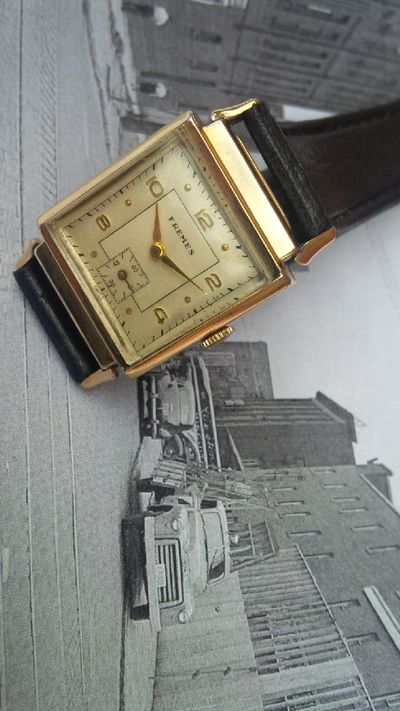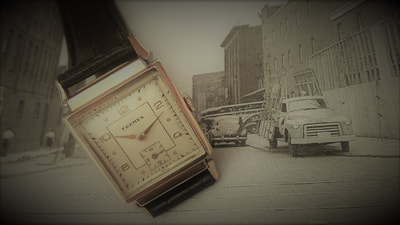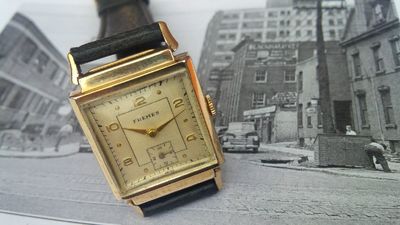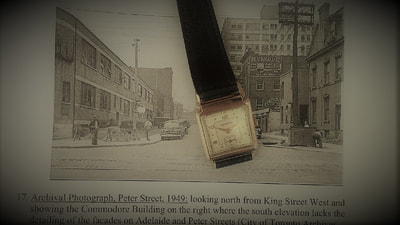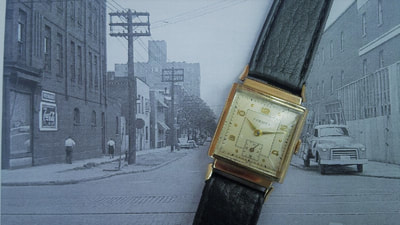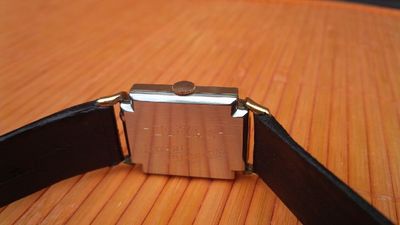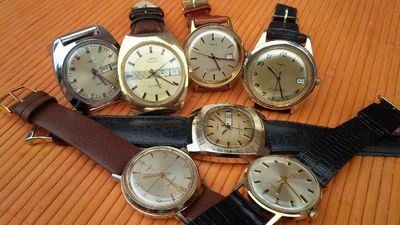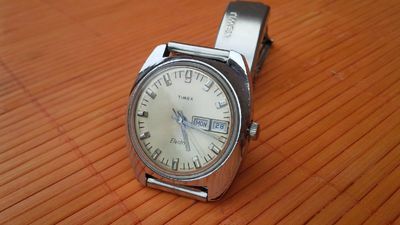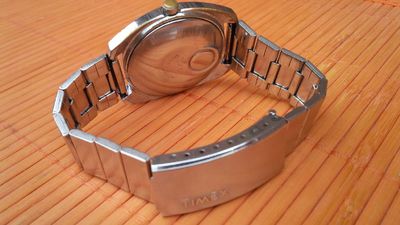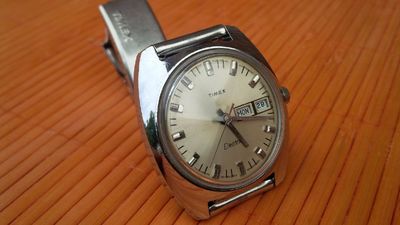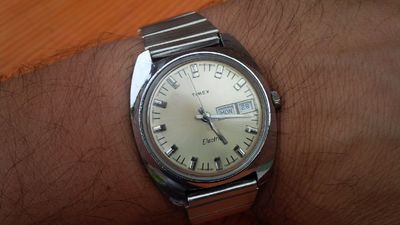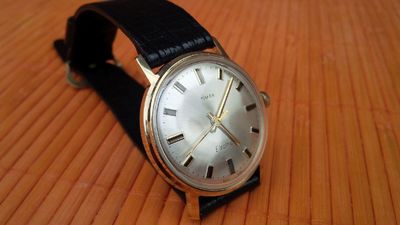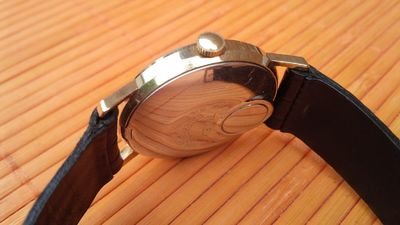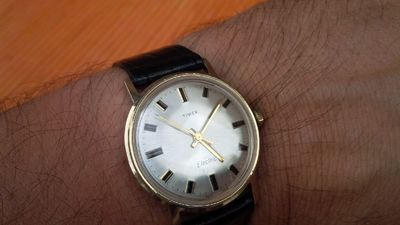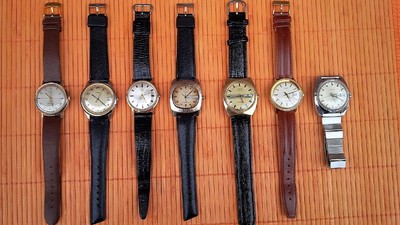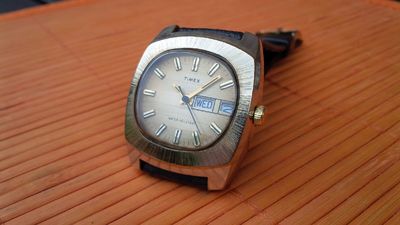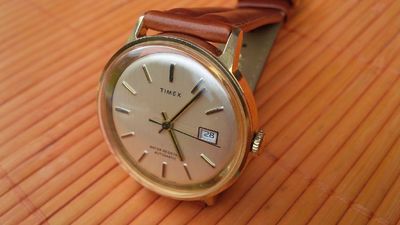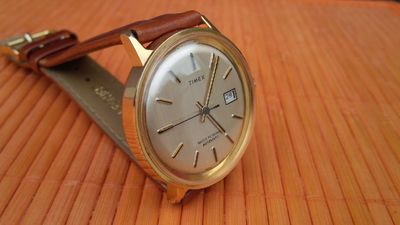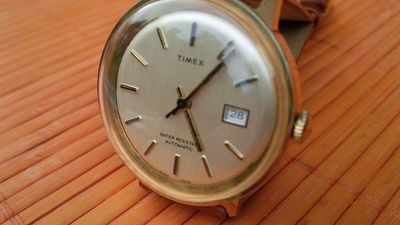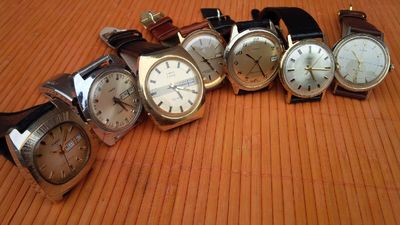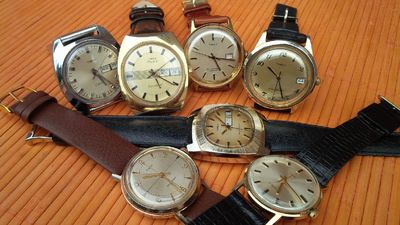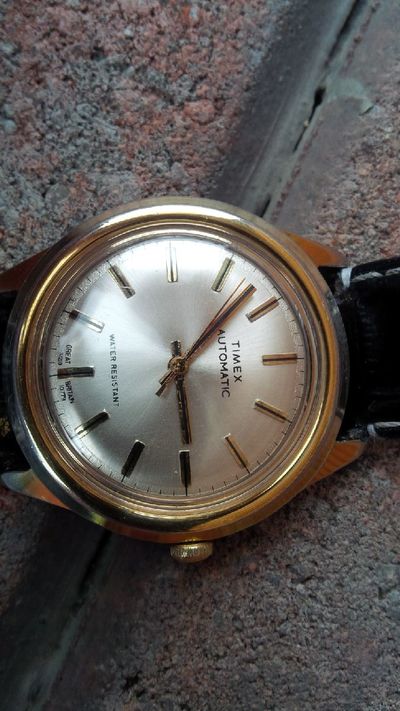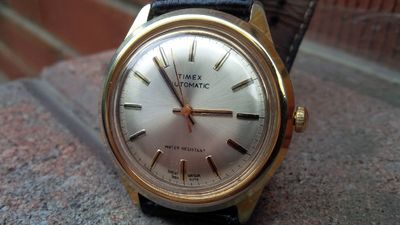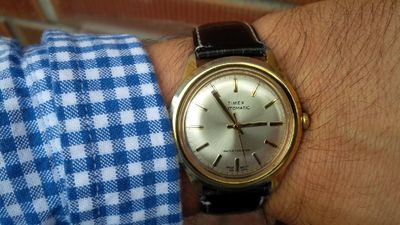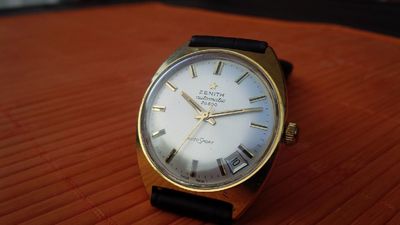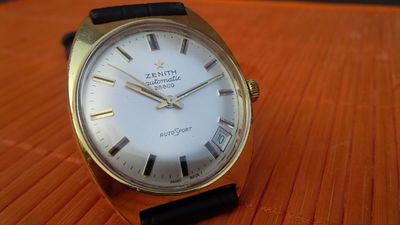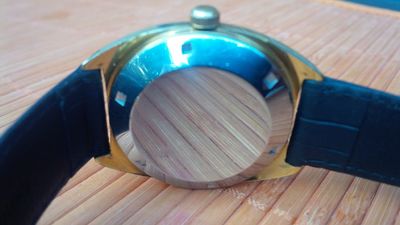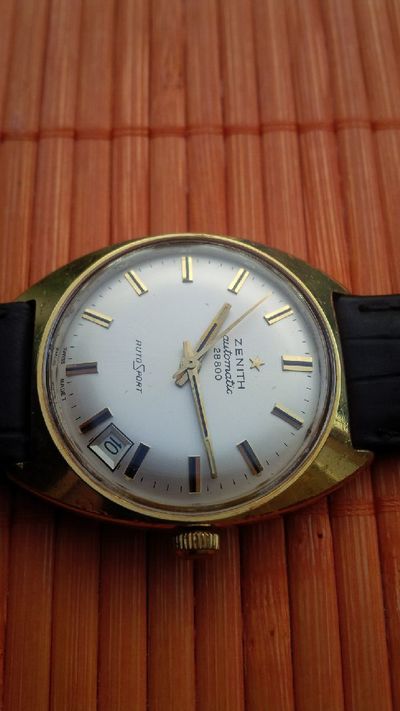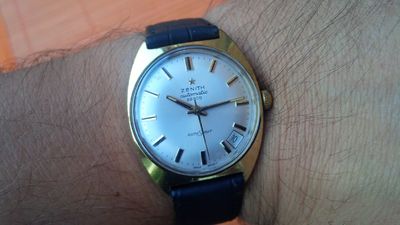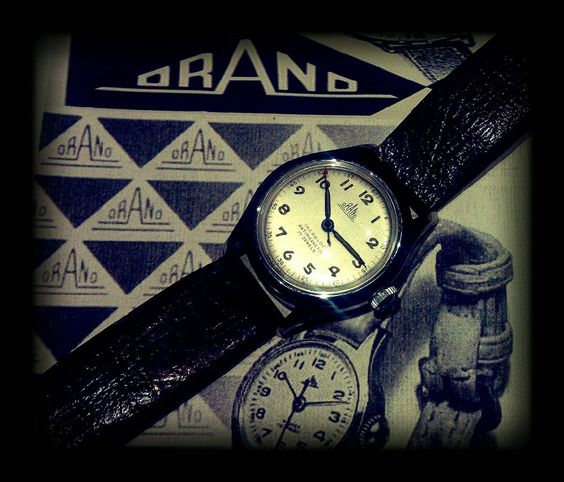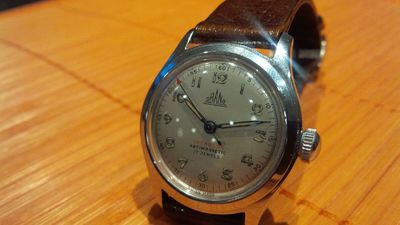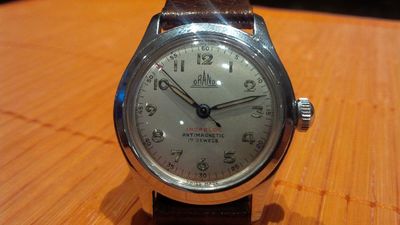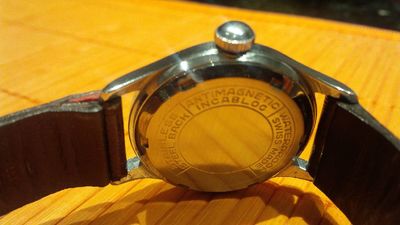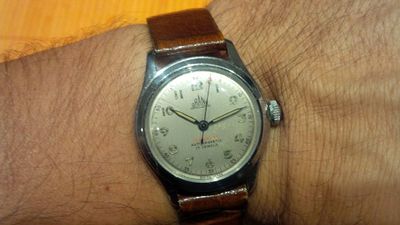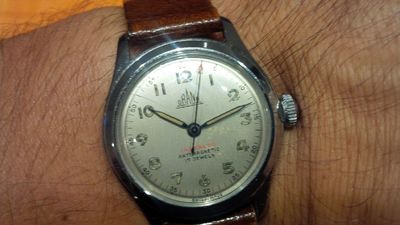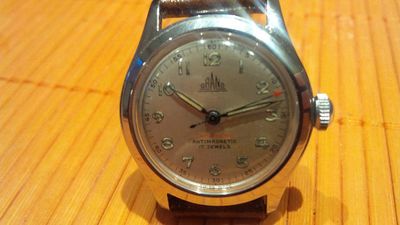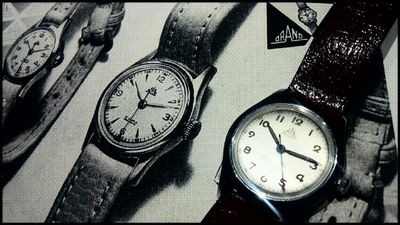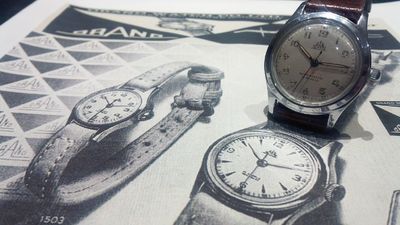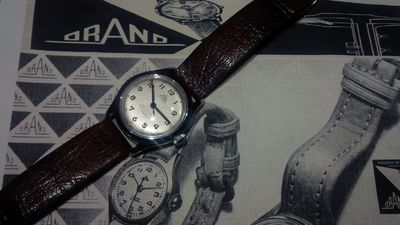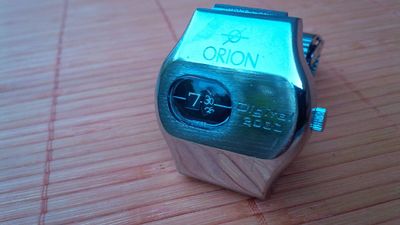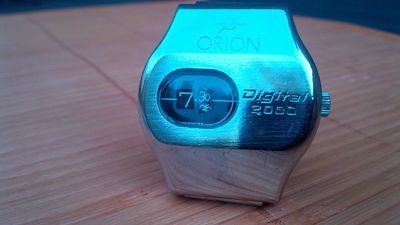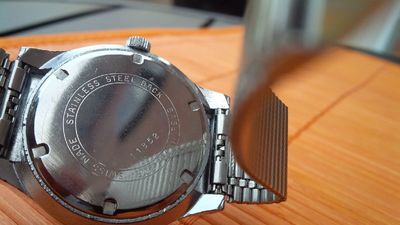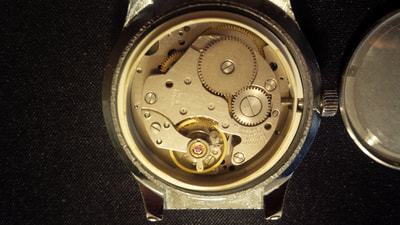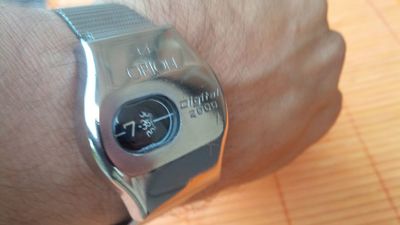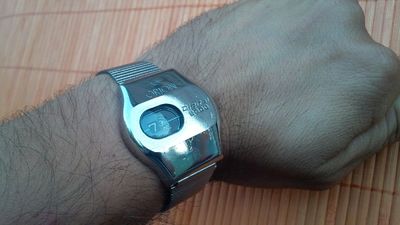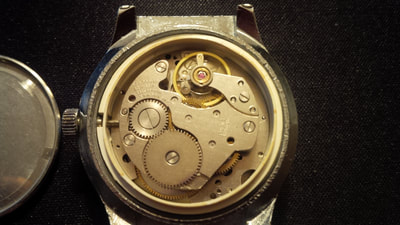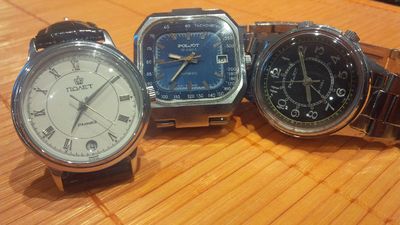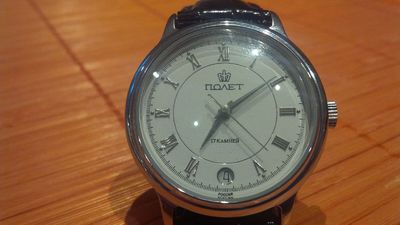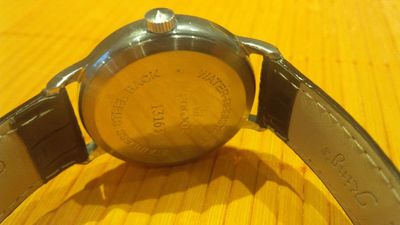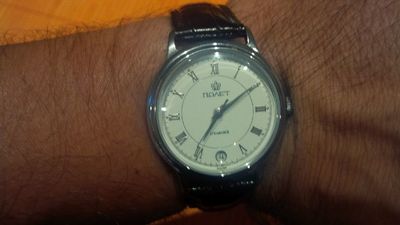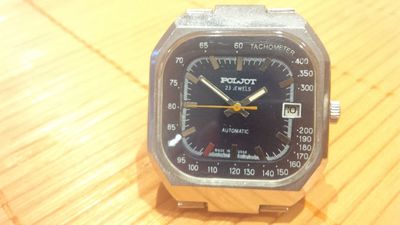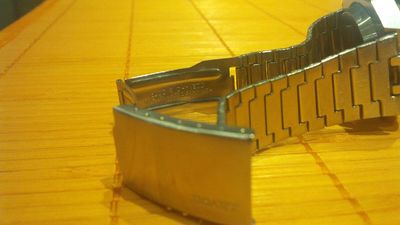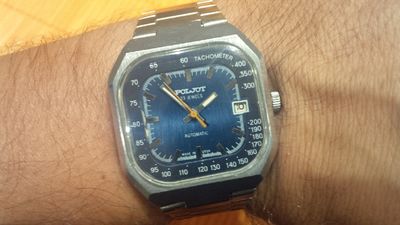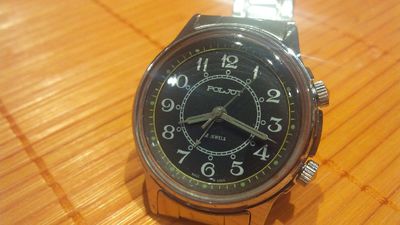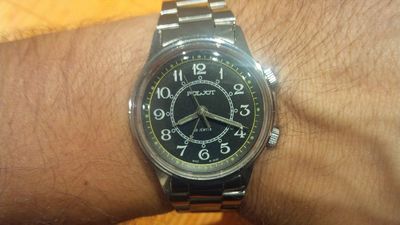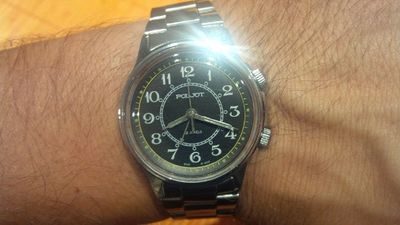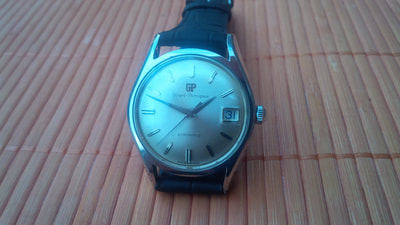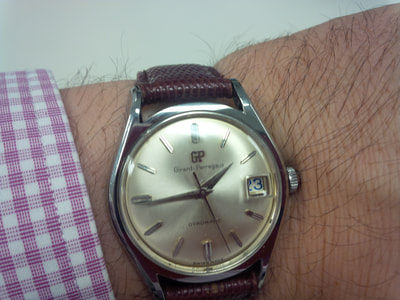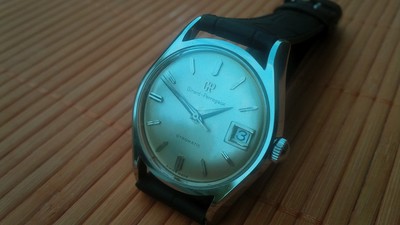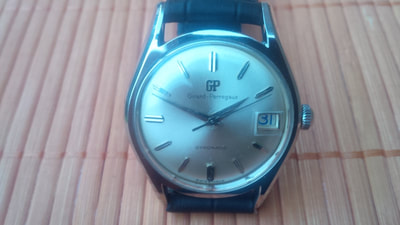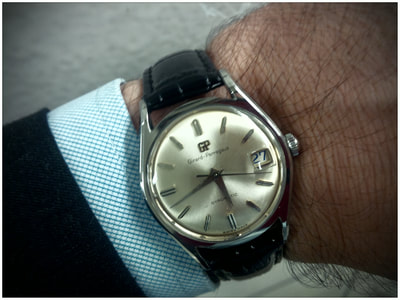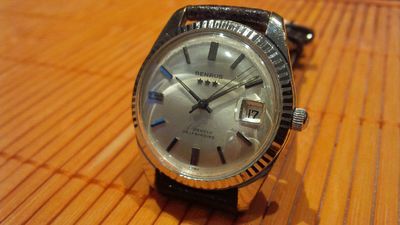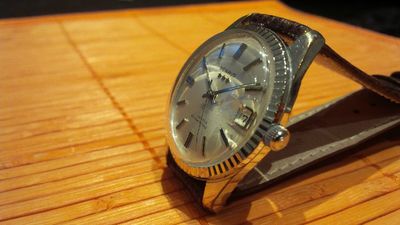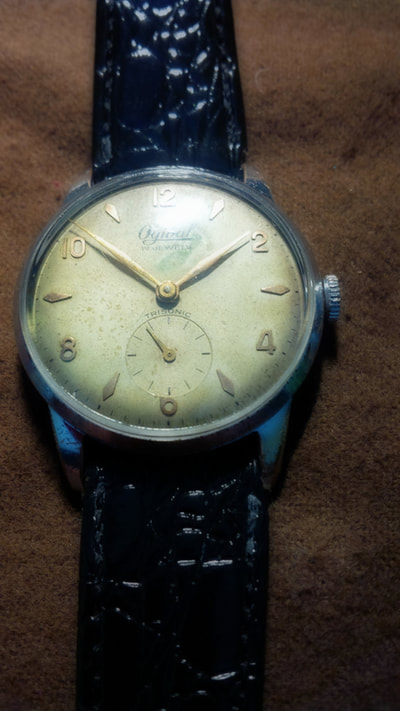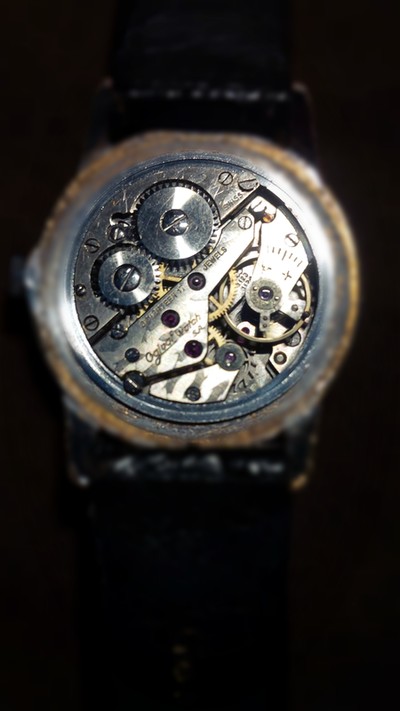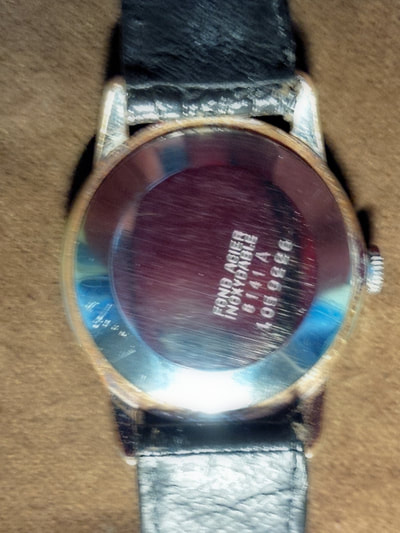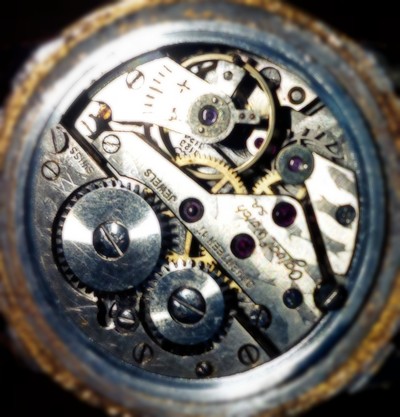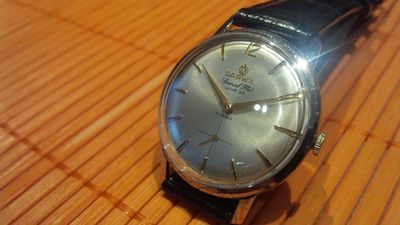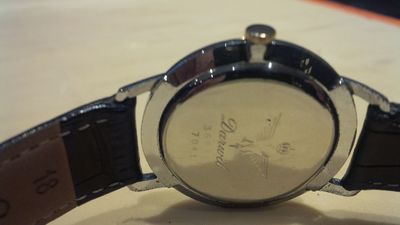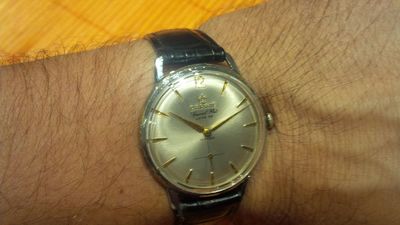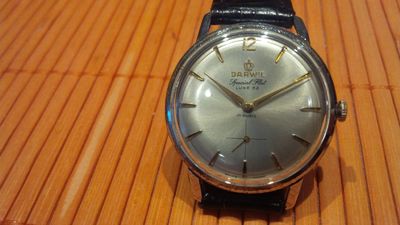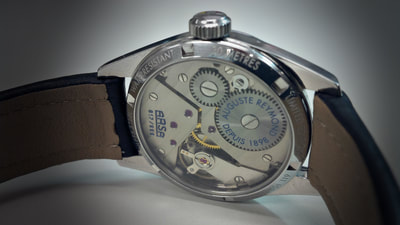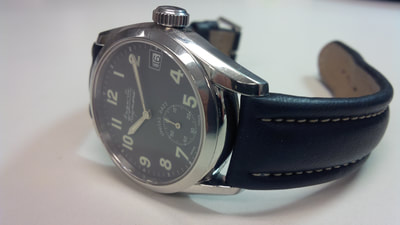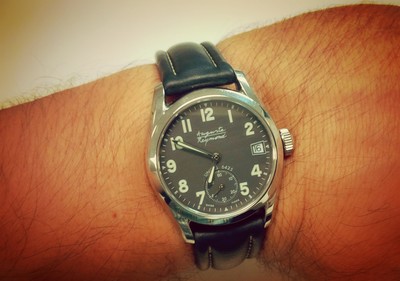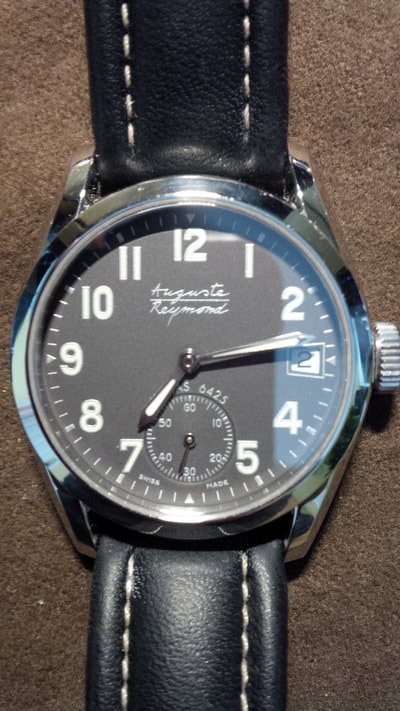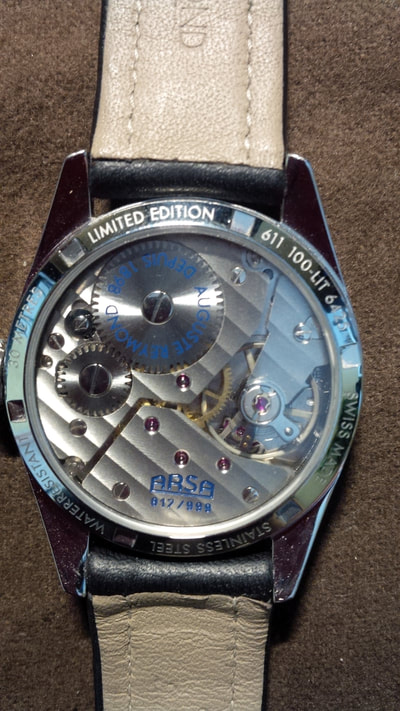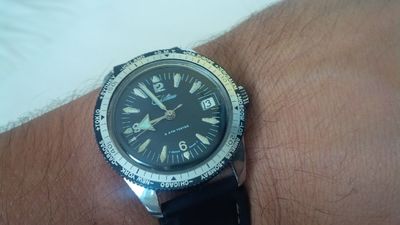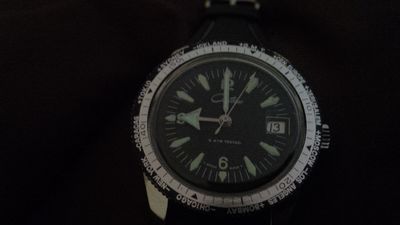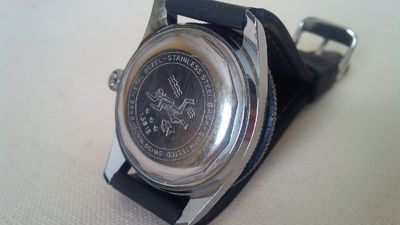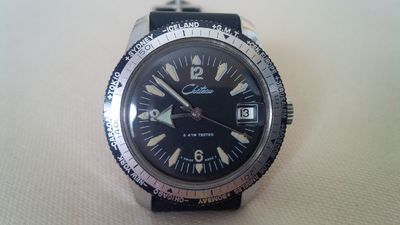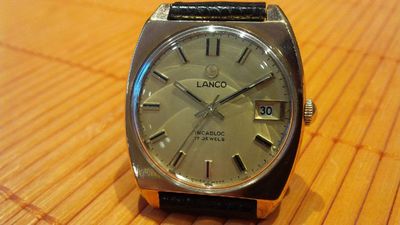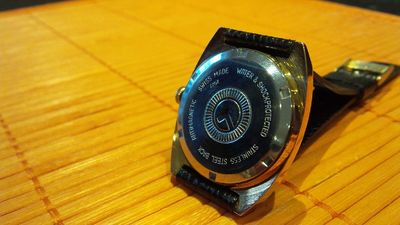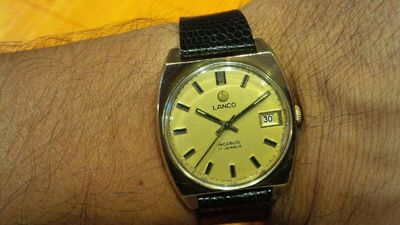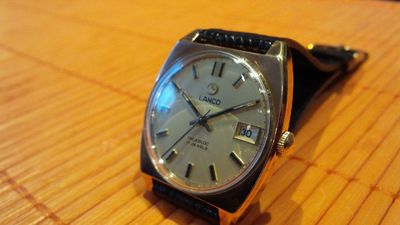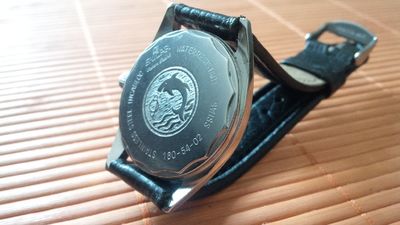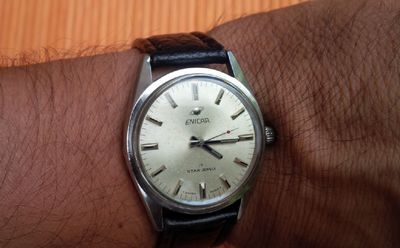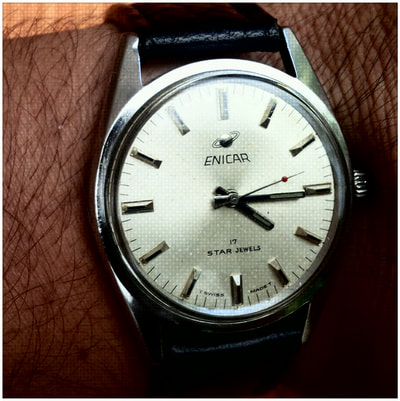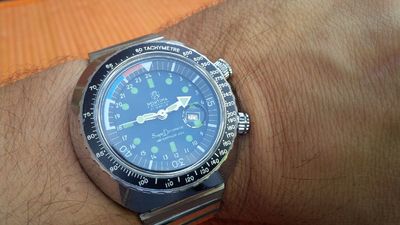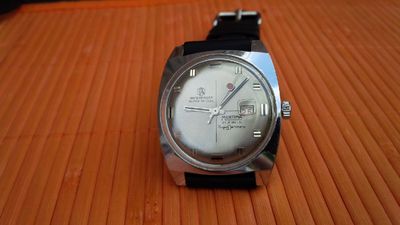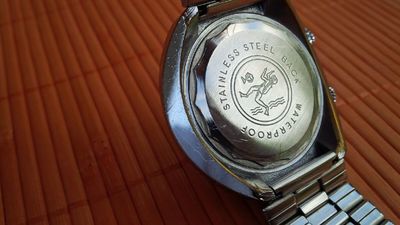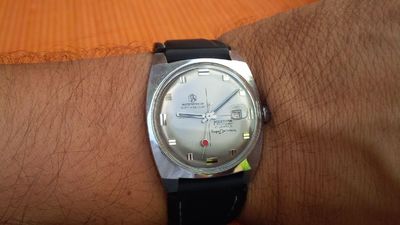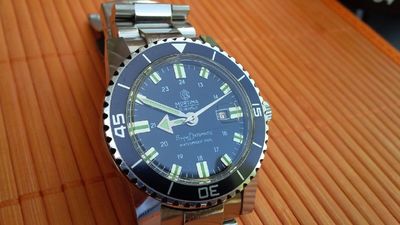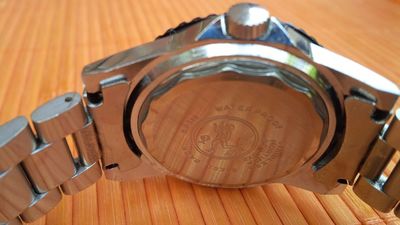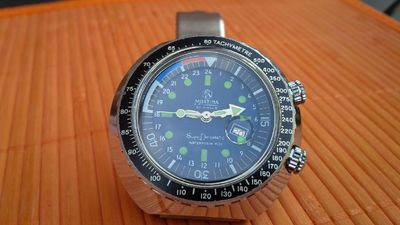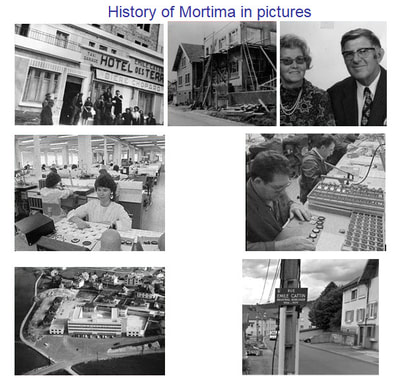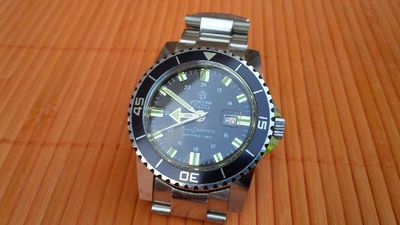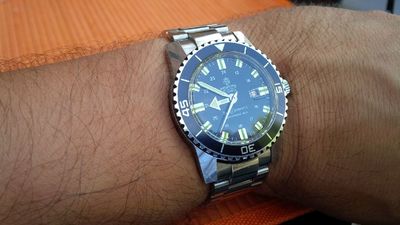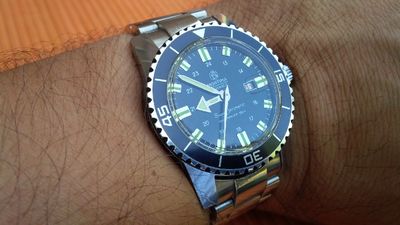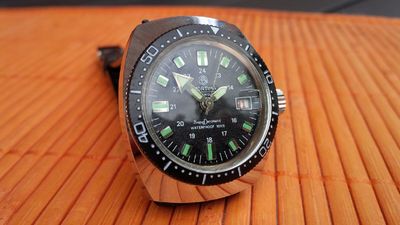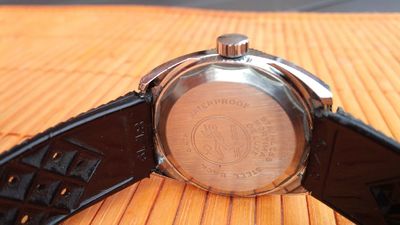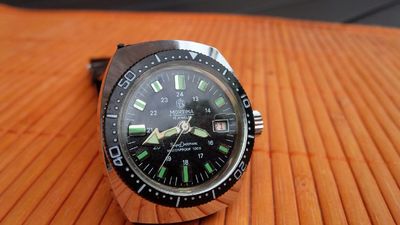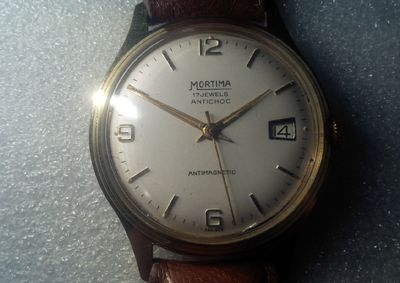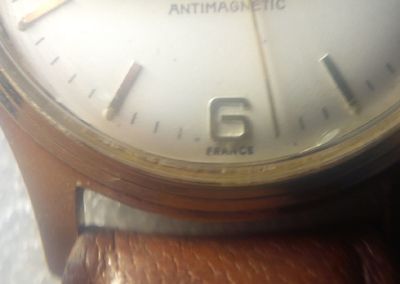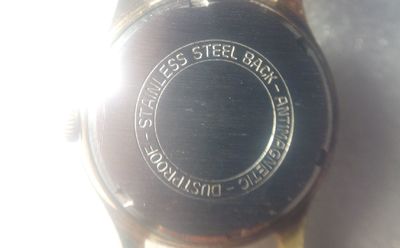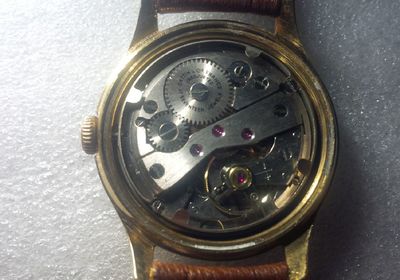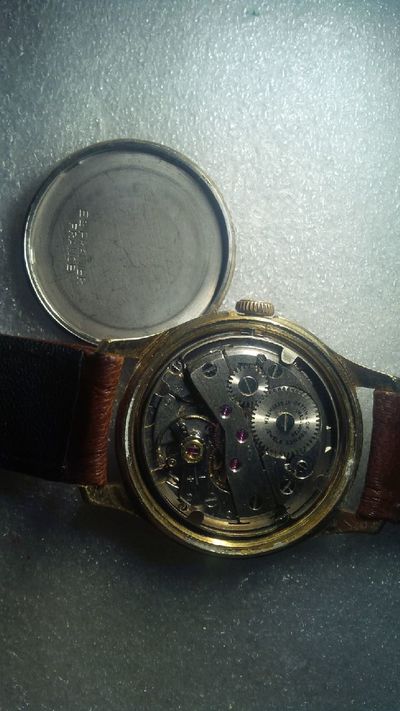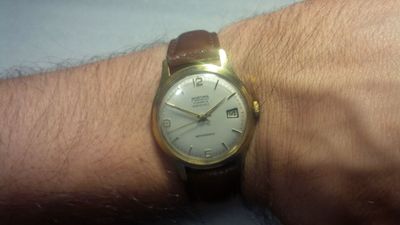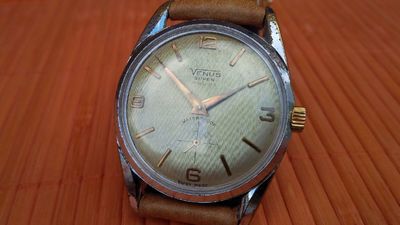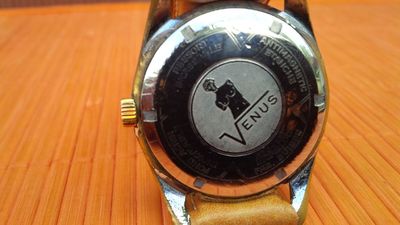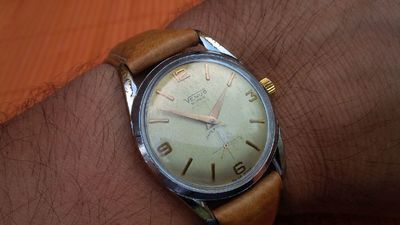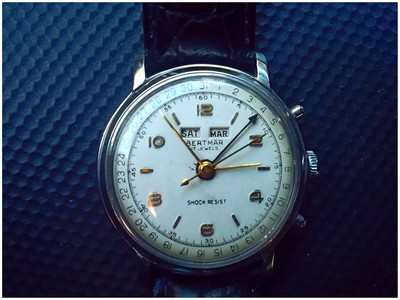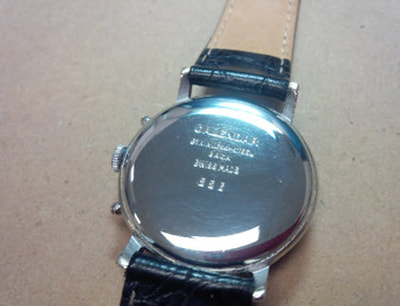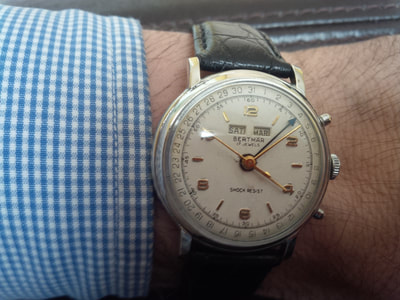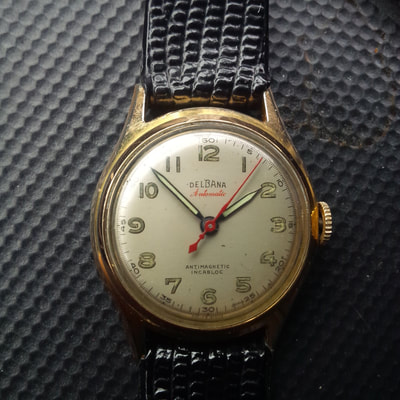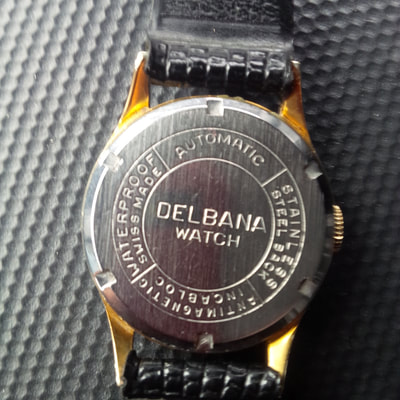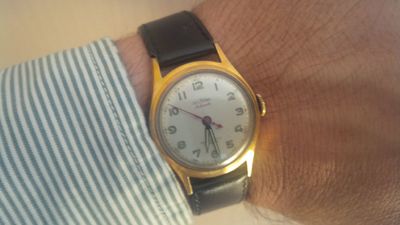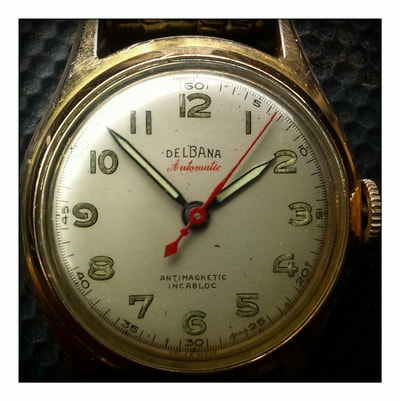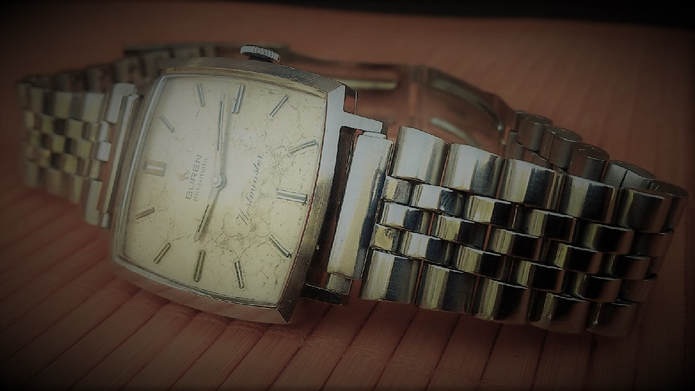 The first ever micro-rotor automatic watch movement was patented by Uhrenfabrik Büren A.G. in the mid 50s. When their "planetary rotor" automatic movement was released in 1957 in the "Super Slender" line, it was one of the flattest automatics of its time and derivatives of the movement competed with the Universal Geneva micro-rotor for thinnest automatic in the world for many years. The most famous implementation of the Buren micro-rotor was to be found in Hamilton's "Thin-O-Matic" line but also could be found for a period in Bulova's "Ambassador" line and Dugena's "Super". Although Hamilton produced Thin-O-Matics with high-grade ETA movements as well, they were so fond of the Buren movement that in 1966 they purchased the company. Hamilton (which became Hamilton International S.A. in 1968) kept producing fully assembled watches under the Buren name as one of their "economy" lines (alongside Huguenin whom they purchased in 1959 and Vantage purchased in 1962). They kept Hans Kocher, Buren's chief designer on as the president of Buren Watch Company S.A. which they owned and operated until Hamilton was in turn purchased by SIHH (now the Swatch Group) in 1971. Buren went into liquidation within months. Founded in 1873 by F. Suter, Buren's first automatic movement (Cal. 525) released in 1945 showed a novel approach to automatic winding that was indicative of things to come. It used a pendulum winding mass recessed into the movement, resulting in a thinner automatic system than other movements of its time. It was a fragile and not particularly efficient system and could not compete with rotor winding systems, even as found in the early bumper automatics of other manufacturers. In 1952 Buren released their first full rotor automatic with bi-directional winding (Cal. 541). It featured a massive rotor surrounding a small (9 1/4-ligne) movement. The smaller movement was made more accurate by the state of the art Glucydur balance and Nivarox hairspring and in 1953 they created the Cal. 538, the smallest automatic calibre with power reserve indicator, a device to assure the public that this new fangled automatic winding stuff really worked. In 1954, through the efforts of Hans Kocher, their chief designer, Buren patented a micro-rotor winding system (they called it a "planetary rotor") that finally saw production in 1957. By 1962, the design had been refined into the Cal. 1280 "Intramatic" which won the Prix D'Honneur at the 1964 Swiss National Exposition in Lausanne. In 1965 it was further refined into the Cal. 1320 (1321 and 1322). Both designs (the 1280 and 1320) featured a slightly larger swinging mass than the earlier models, which now swung over the center of the movement, necessitating indirect seconds and minutes (I'll explain that later). Like the "Super Slender", the "Intramatic" wound in both directions and featured mutual decoupling of the automatic and manual winding systems (more about that later also) in an attempt to capitalize on all the winding power that could be squeezed out of its tiny rotor. It was the "Intramatic" movement that Buren modified in a joint venture with Breitling-Leonidas, Dubois-Depraz, Hamilton (who owned Buren at that time) and Heuer to create one of the world's first automatic chronographs in 1969, the "Chronomatic". The "Chronomatic" featured a Dubois-Depraz chronograph module (8510) attached to the backside of the movement, effectively hiding the micro-rotor entirely within the movement. The last automatic movement that Buren made was the Cal. 82, which utilized twin barrels on either side of the center wheel pinion and a large central rotor. It could run at 28,800 bph or 36,000 bph and experiments were made with a 43,200 bph escapement. It was quite thick for its time (at 6.2 mm) and consequently only two or three hundred watches were ever completed with the Cal. 82 movement. The remaining parts for approximately 100,000 more were sold to Comor in 1971. Micro-rotor movements are aesthetically much more pleasing to my eye and Buren can be proud to have been the first company to introduce them to the watch buying public. Despite the obstacles that had to be overcome, they succeeded in making a very thin, very accurate automatic movement by employing revolutionary mechanisms that functioned reasonably well in a variety of different levels of execution and elaboration. As a classy example of a turning point in the history of both Hamilton and automatic movements in general, a Buren powered Thin-O-Matic makes for an interesting, horologically significant addition to any watch collection. 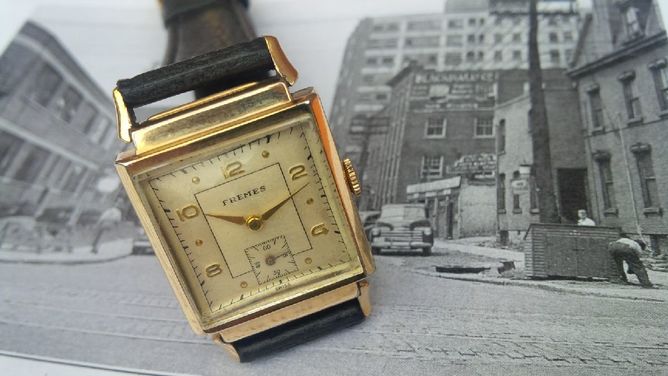 Here’s another watch with great local history. Fremes watches were created and sold in Canada by members of the Fremes family. The company was owned by Simon Fremes who was president of S.Fremes and Co. Ltd., manufacturing jewellers on Adelaide St. West. The business was based in Toronto, Canada. For the manufacturing of their watches, swiss watch movements were purchased in Switzerland and faces and cases were designed and built locally in Toronto. It wasn’t uncommon for local jewellery manufacturers in the beginning of the century to manufacture and sell watches locally. From the City of Toronto Archives we learn that the “Commodore Building” located at 317 Adelaide St. West, was built by Simon Fremes, a local jewellery manufacturer. The King Spadina neighbourhood, named for the intersection of the two major streets that cross it, took on its 20th century character after the Great Fire of 1904 destroyed the city's original Manufacturing district.. Among the first men to acquire property in King Spadina was Samuel Fremes, a local jewellery manufacturer who, in 1912, commissioned the Fremes Building on the southwest corner of Adelaide Street West and Peter Street. It is now designated as a heritage building. The business most likely shut down in the 1950's.
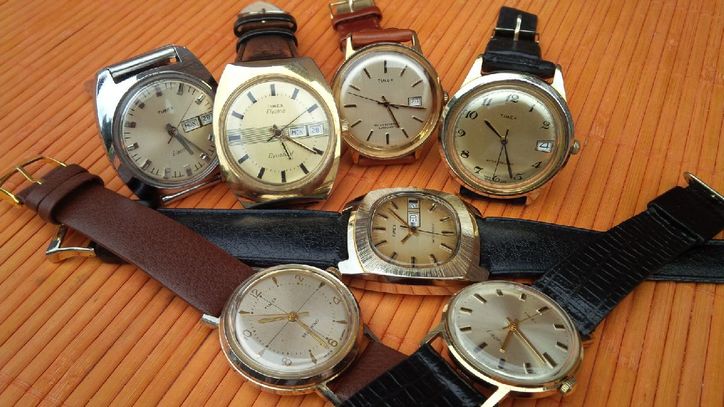 Timex creativity and experimentation has helped them grow as a brand, and their consistently affordable prices have made them popular with watch fans. The History of Timex 1854 – 1950 When brass manufacturer Benedict & Burnham decided to start manufacturing clocks with brass in 1854, they initially traded under the guise of ‘The Waterbury Clock Company’. Becoming legally incorporated in 1857, their whole ethos was bringing the same luxury designs being imported from Europe to the masses in the United States, at accessible prices. They quickly reached this target, swiftly becoming one of the largest producers of watches and clocks in both the US and internationally. Originally producing copies of more expensive designs, it wasn’t until 1887 that they designed and created their Jumbo pocket watch. By now the company name has changed to the Ingersoll Watch Company, and the success of their newest design caught the attention of salesman Robert H. Ingersoll. With the help of Robert and his brother Charles, the brand created the Ingersoll Dollar Watch, selling them for, as you might have guessed, a dollar, and taking the market by storm. The brand grew at a rapid rate, and by 1878 they were producing over 200 pieces a day, having to upgrade to a larger factory to keep up with the demand. Despite the fact that the quality was high, the price was cheap, and the popularity for the brand was only growing, poor sales techniques meant that the watches were being sold at a loss, and the company soon fell close to bankruptcy. It wasn’t until WW1 when artillery gunners needed to read time while still using their guns that Ingersoll began to crawl back from the depths. They modified one of their women’s designs, the Midget pocket watch, and changed it into a precise and well crafted military-issue wrist watch. The first of its kind, the design revolutionized watch making, and helped with the production of the wrist watch we see today. The military may have helped with Ingersoll’s design elements, but it was Disney that helped propel it back into the commercial spotlight. 1930’s America was still suffering from post-depression hardship, and a little character called Mickey Mouse seemed like a good way of creating some much needed cheer. Joining with Disney, Ingersoll created the famous, and hugely popular Mickey Mouse watches and clocks, and this success helped cement them as a respected and popular brand. 1950 – 1970’s It wasn’t until the 1950s that Timex finally got its name, and by then it had improved its mechanisms to make its products run at an improved rate and with cheaper manufacturing steps. With advertisements showcasing its practically indestructible built, “It takes a licking and keeps on ticking”and charismatic anchorman John Cameron Swayze hosting their product demonstrations. Slogan: It takes a licking and keeps on ticking The new watch movement design faced resistance from traditional jewellers. A marketing decision was made to use the most credible newsman in the United States at that time, John Cameron Swayze as a spokesperson for live torture tests on television with the tag line created by Russ Alben, "Timex – Takes a Licking and keeps on Ticking", a well-recognized campaign in advertising history. These commercials were developed by Hirshon Garfield as elaborations on tests originated by United States Time Corporation salesmen. The commercials included high-divers, water skiers, a dolphin, dishwashers, jackhammers, paint mixers and the propeller of an outboard motor, all torturing a Timex watch. Timex watches gradually became known for their reliability and superior design. As they insisted that jewellers only marked up their watches by 30%, many outright refused to stock the brand. To counteract this, head of marketing, Robert Mohr, built a distribution network of drugstores, department stores and other, then unusual, points of sale. By the 1960s, sales were reaching in excess of $70 million. In recognition of the Timex brand's worldwide success, United States Time Corporation was renamed Timex Corporation on 1 July 1969. By mid to late 1960’s, attempting to keep up with the rapidly changing marketplace – Timex began producing digital (electric) watches. While troubles in the company at both a production and management levels, the company struggled to maintain it’s market share in a now predominantly electronic market – with most of their watches retailing at nearly double that of their competitors. By the time the 70s rolled around however Timex had taken a dip again. Their contracts with various brands, including Disney, had ended, competition from modern watch companies had increased, and an ill-advised venture into home computers only caused the business to waver even more. 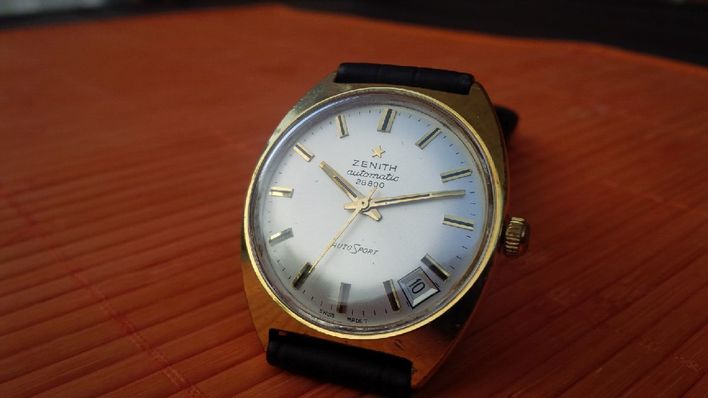 Late 60’s / early 70’s gold-plated Zenith Autosport, really a joy to wear. Late 60’s / early 70’s gold-plated Zenith Autosport, really a joy to wear. Only 22 years young, in 1865 Georges Favre-Jacot founded the „Fabrique des Billodes“ in Le Locle. First he manufactured precision pocket watches, which were signed with his name. About 1900’s the product range was expanded: There were on-board chronometers, table clocks, precision pendulum clocks and later, marine chronometers. The name "Zenith" came to his mind, when he just had developed a movement which seemed to him more perfect than all previous; looking up at the sky full of stars the sky appeared to him similar to the game of the wheels and cones in a perfect mechanical instrument, and he decided that his new movement and it manufacture should be named after the highest point of the universe: the zenith. From this emerged also the choice of a five-pointed star as corporate icon. From 1903 the Favre-Jacot company took part regularly and very successfully in the competitions of the observatory Neuchatel with it’s pocket watches and on-board chronometers.In 1903 he achieved a first prize in the competition of the observatory of Neuchatel. The nephew of Favre-Jacot, James Favre sold the watches to North and South America, Russia, India, China and Japan. In 1908 followed the establishment of a branch in Moscow, 1909 in Paris, 1910 in Vienna and 1914 in London. By transforming the firm into a stock company in the year 1911 the Zenith brand arose. In the same year Favre-Jacot retired and handed the management of the company over to James Favre. By James Favre, there was a revival of old traditions, especially with the "neuchâteloises". These new pendulum clocks were equipped with a 8-day carillon and on demand had also a quarter hour repetition. In 1923 he founded another company in the French Besancon and 1926 an additional office in New York. In May of the year 1929, the astronomical observatory in England told the public that out of 19,835 watches from all over the world a watch by Zenith set a new record with a daily deviation of only 0.6 seconds. After the First World War Zenith began with the development and manufacture of wrist watches including alarm and chronograph functions. Zenith was instrumental in developing the now-standard central seconds complication, with the direct arrangement of the 1948 calibre 133 now widely used. For the chronographs movements by Valjoux, Excelsior Park, and from 1960 on by Martel were used, which were bought by Zenith. In 1971 the majority of shares of the company is taken over by the American Zenith Radio Corporation of Chicago, America's largest group for the manufacture of electronic components. One of the reasons, perhaps, was to exclude problems the Americans feared because of the name similarity. Zenith was planned to be used as a base for sales of quartz movements produced in the U.S. Believing in their imagination of the future the Americans soon lost interest in the mechanical movements and in 1978 ordered the production to be stopped and all movements and machinery to be destroyed. It is thanks to the head of the chronograph studios, Charles Vermot, that the 'El Primero' was saved for the after-world. He objected to the order and hid large quantities of plants, tools, machines, and all design and manufacturing drawings in the attic of the manufacture. End of 1978, the Zenith brand was sold to the Swiss Dixi group. With the support of the watch manufacturer Ebel the production of the 'El Primero' was resumed. First the movements of Ebel were used, but since 1984 there were again watches from Zenith. After Zenith, together with TAG Heuer, had become part of the luxury goods group LVMH, the brand was positioned as a luxury watch brand of the top class. Zenith plays a special role within the group as supplier of manufacture movements. Vintage late 1940's to early 1950's watch made by ORANO - "Fabrique d’horlogerie ORANO Montres S.A. Longeau". The logo has an "art deco" feel to it and I just love it.
All I can find on Orano Watch Co. Ltd. is that they were manufacturing watches since 1918 in Longnau, Bienne Switzerland. 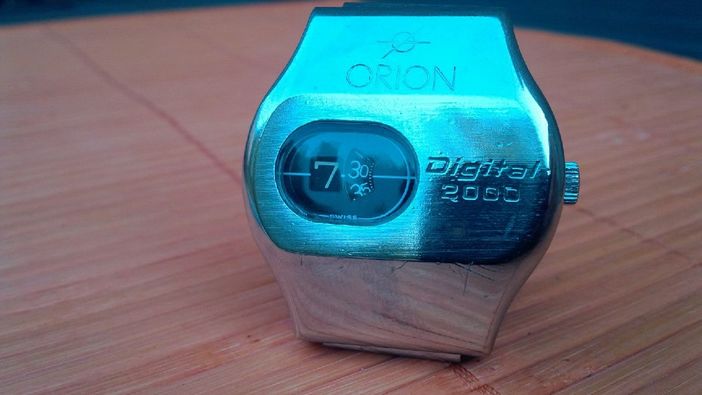 What is a jump hour watch? A standard watch displays time while the hands are rotating over a dial with hour and minute markings around it. The "jump Hour" watch displays time through a small window with actual numbers. The numbers are located on movable discs which move as the mechanism moves. It should be noted that hour markings, positioned on the edge of the rotating circle, jump in the window while the minute circle moves in a continuous fashion. The internal hour disc moves continuously as well, however, just before the full hour is completed, one spring pushes on the actuating triangular lever which then jumps in a space between two cogs and causes the sudden turn or "jump" of the hour disc on which the numbers are located on. According to available data, the first wristwatch with digital time display is attributed to prestigious watch making company Audemars Piguet which launched such a watch in 1921. It is interesting that the trend for jump hour watches repeats every forty to fifty years – twenties and thirties, then in the seventies. Today they are becoming more visible again. The 1970s saw a massive rise in the popularity of the jump hour watch. That particular decade saw a major economic downturn and people moved away from watches as "status symbols" towards watches as statements of individuality. It was during that time that skip hour watches became popular with their innovative and space age designs. Pictured here is a vintage 1970’s Orion Digital 2000 Jump Hour Men's Watch. It is a rare piece that houses the original wind up Swiss Made Baumgartner 582 caliber movement signed: “Basic watch one jewel un-adjusted Swiss Made 21`600 a/h calibre : bf 582 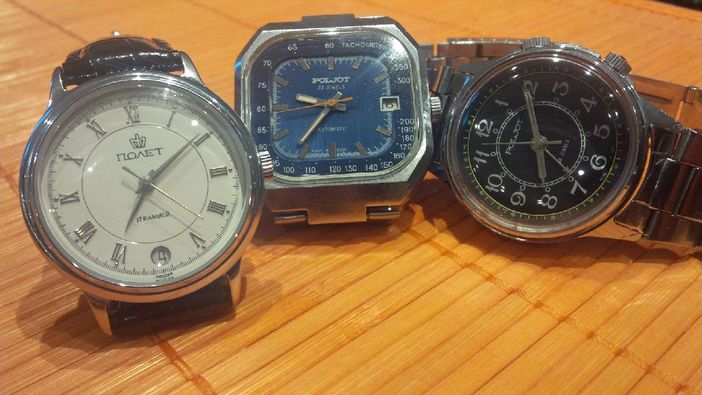 Founded in 1930 under orders from Joseph Stalin, the First State Watch Factory was the first large scale Soviet watch and mechanical movement manufacturer. Via its USA-based trading company ‘Amtorg’ the Soviet government bought the defunct 'Ansonia Clock Company' of Brooklyn, New York in 1929, and the Dueber-Hampden Watch Company of Canton Ohio. It moved twenty-eight freight cars full of machinery and parts from the USA to Moscow in order to establish the factory. Twenty-one former Dueber-Hampden watchmakers, engravers and various other technicians helped to train the Russian workers in the art of watch making as part of the Soviet's First Five-Year Plan.. The movements of very-early products were still stamped "Dueber-Hampden, Canton, Ohio, USA" (examples of these watches are very collectible today As the Germans closed in on Moscow in 1941, the factory was hurriedly evacuated to Zlatoust. By 1943 the Germans were in retreat, and the factory moved back to Moscow, adopting the "First Moscow Watch Factory" name (Russian: Первый Московский Часовой Завод - 1МЧЗ). In 1947 the first wrist watches under the brand name "Pobeda" and the first Marine Chronometers and Deck watches were produced. By 1951 the production of wrist watches had increased to 1.1 million. In 1975 new machinery and equipment for manufacturing complex watches was imported from Switzerland. The first chronograph "Okean" (caliber 3133) was produced for the space station "Sojuz-23." The Poljot/πωλετ brand was established in 1961 in the Soviet Union, with watches from the First Moscow Watch Factory becoming very popular there. Among the output of the company was the watch of Soviet military aviator and cosmonaut, Yuri Gagarin, who wore a "Sturmanskije" during his flight. In late 2003, rumors predicting the demise of the Poljot brand circulated on the Internet. According to the rumors, the First Moscow Watch Factory was to cease producing their own models and become a source of inexpensive movements for other European watch brands. These rumors never came to fruition. 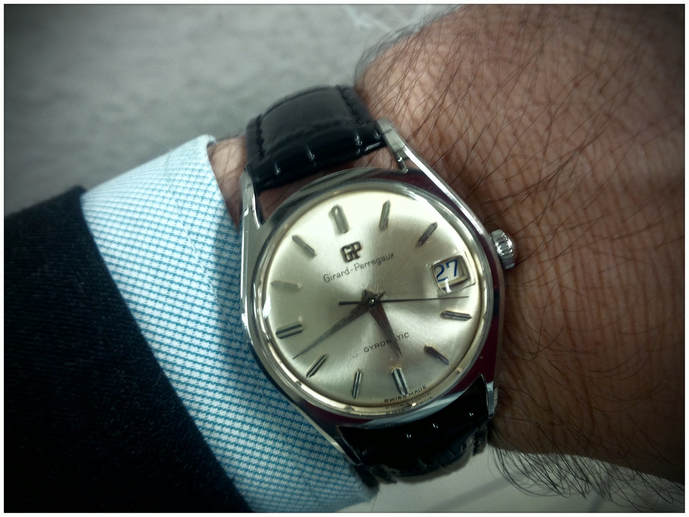 Swiss watchmaker company Girard-Perregaux was founded in 1791. The founder of the company is Jean-François Botte. In 1854, the watchmaker Constant Girard-Oaten married Mary Perregaux, her family was engaged in manufacturing of watches. In the long list of registrations that followed, here are some examples of the ingenuity of the Girard-Perregaux researchers: in 1933, they presented a clever system of interchangeable bracelets. In 1942, when calculators as we know them today were still in the land of dreams, a watch with a calculating ruler was created. Four years later, a watch displaying several time zones was patented. In 1949, it was an alarm watch with a sound amplifier in its case. In 1965, it was the turn of the high frequency movement, Gyromatic HF, the famous 36,000 vibrations/hour, still considered by some today as the last useful improvement made to the mechanical watch. The famous Observatory Chronometerwatch was equipped with Gyromatic HF. In 1966, the Neuchâtel State Council decided to recognise the work and developments of Girard-Perregaux by awarding the Brand the Observatory Centenary Prize. In 1969 the Swiss watch industry was shocked with quartz movement. Many well-known companies wary of new invention, but the company Girard-Perregaux is not one of them: the company builds the mass production of Swiss Made quartz model. The oscillation frequency of the pendulum (32 768 Hz) would later be adopted as a standard throughout the world. In 1970, Girard-Perregaux presented the first quartz watch produced industrially in Switzerland. It was also the first watch in the world to be fitted with a quartz movement that vibrated at 32,768 Hertz, the frequency adopted universally by manufacturers today. Closer to home, between 1985 and 1997, it’s a mechanism with a perpetual calendar that was presented and perfected. Not content with automatically correcting the ends of the months with less than 31 days, including during leap years, it displayed time cycles that were less common in a wrist watch, such as the signs of the zodiac, the seasons or the solstices and the equinoxes In 1987, the market appears GP 7000, chronograph, which became a classic of modern production sports watches, his appearance pushes the company Girard-Perregaux in close contact with the world of sport.. In 2001, a column-wheel chronograph mechanism was registered, with dimensions enabling it to be fitted to ladies watches. These last years, Girard-Perregaux has presented a lot of novelties which reveal this innovative spirit. And this long tradition of inventions is not about to come to an end. At the moment, The Research & Development team is working on an important project concerning chronometry. 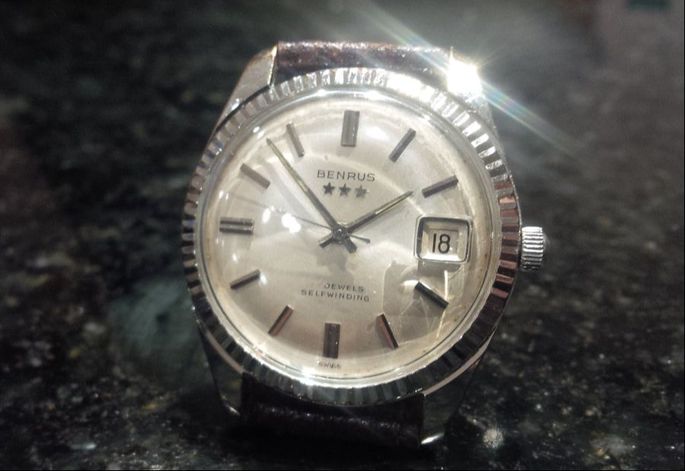 Benrus Watch Company was a family owned American company founded in New York City in 1921 by three brothers – Oscar, Benjamin, and Ralph. The ambitious brothers were Romanian immigrants. The name "BENRUS" was a combination of Benjamin Lazrus first and last names. Hence "BEN"jamin Laz"RUS". Before 1930, the company transitioned from watch repair to manufacturing watch cases and assembling watches using imported internal components from Switzerland. The original company headquarters were located in the Hippodrome building on 44th Street in Manhattan NY. While some watch assembly took place there, the bulk of the manufacture took place in La Chaux-de-Fonds Switzerland. Benrus owned a factory in that location where watch movements were assembled. During World War II Benrus, like many other watch manufacturers of the time, produced watches for the military servicemen. Also during that time they switched to the manufacture of timing systems (e.g. fuses) used in munitions. In the 1940s and 1950s, Benrus released the Sky Chief chronograph,the Dial-a-Rama, the Wrist Alarm and a bracelet watch called Embraceable. In the early 1950s, Benrus failed in a hostile takeover of Hamilton Watch Company and subsequently lost a legal battle with Hamilton in which Benrus had acquired 24% of Hamilton stock for the stated purpose of investment but for the actual purpose of control of the company. Hamilton believed Benrus was attempting to obtain enough stock in an effort to control the company and sued Benrus claiming violation of US anti-trust laws. Benrus contended that the shares represented an investment as a hedge against a 1952 proposal by the U.S Tariff Commission that recommended an increase of import duties on Swiss watch movements which would be quite damaging to Benrus who relied solely on Swiss made movements. In contrast it would prove to be beneficial to a company manufacturing watches in the US such as Hamilton. In 1953 Hamilton won an injunction against Benrus. The decision in this case has become a part of the U.S Department of Justice's Manual in regard to the establishment of preliminary injunctions in antitrust cases. In the 1960s, the company introduced self-winding watches and entered into the automobile market with steering wheel-mounted self-winding clocks. Also in this decade, Jerry Lewis was hired as a pitchman for the company's Belforte brand. In the early 1960s, the Federal Trade Commission determined that Benrus' marketing practices--specifically, its published “list prices” were misleading for a substantial minority (about 14%) of potential customers at the time. The company was then sold to Victor Kiam of Remington Razors in 1967. Over the next ten years, the company suffered in competition against inexpensive Japanese wristwatches, adopting a strategy of diversification into military timepieces and costume jewellery. Nonetheless, Benrus filed for bankruptcy in 1977. 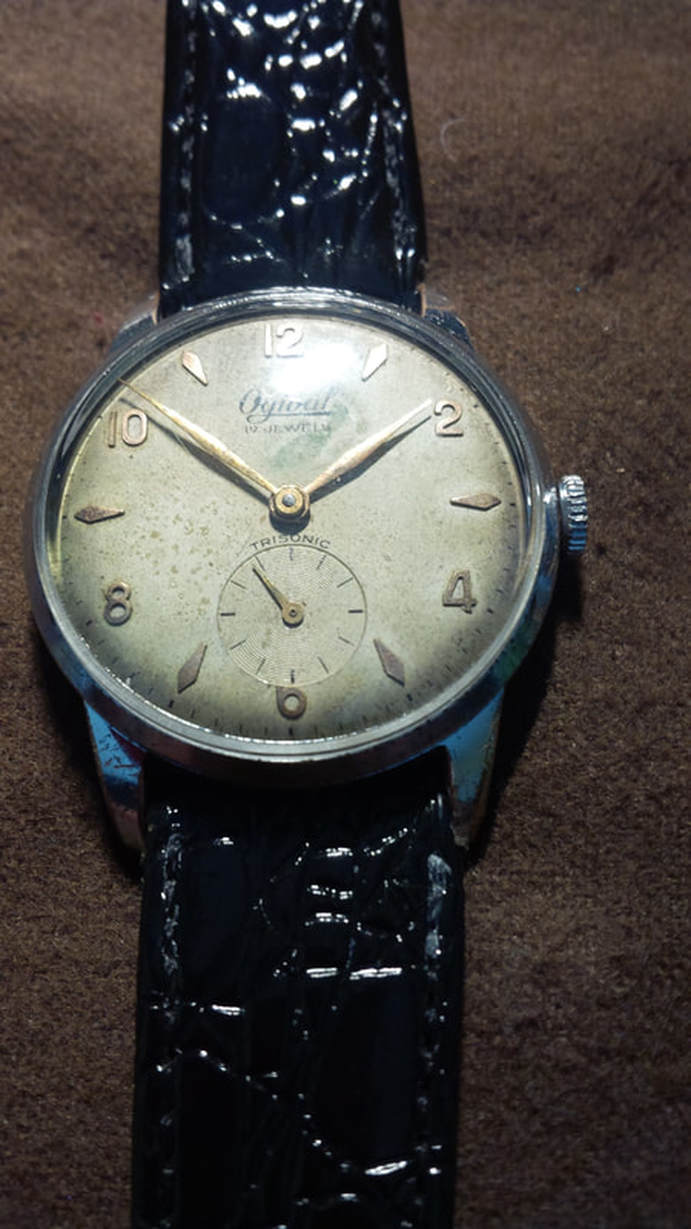 Ogival reflects a 115 year watch craftsmanship. The Ogival watch company was founded in La Chaux-de-Fonds, Switzerland, in early 1903, by Mr. Rene Brandt, a talented watchmaker who was always striving to create unique high-quality models of wristwatches. Very soon Ogival watches won a worldwide popularity, and became a symbol of high quality and durability. Over the whole history the Ogival company headed by Mr. Rene Brandt was able to enlarge the watch market with its various and exclusive models of watches. But the Ovigal company does not limit its collections with luxury jewelry watches only. The brand's rich range includes chronometres, chronographs and so on. In 1958 members of some expeditions to the Pyrenees, France and the Upper Garonne river had water-resistant Ovigal chronometres on their wrists. According to the members, the success of the expeditions was high-precise and reliable watches of this Swiss watch brand. 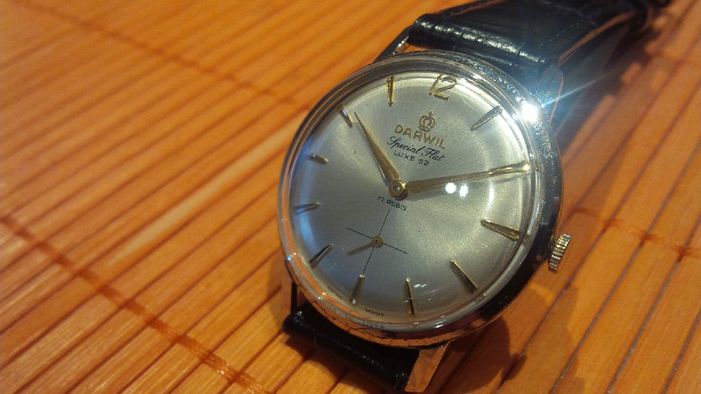 Great vintage watch from an obscure company. It was a popular brand marketed primarily in Italy and the Balkans during the 60’s and 70’s particularly in former Yugoslavia. There was nothing special about these watches, but they were well balanced between price and quality as well as reliable and accurate machines. They were a kind of substitute for Longines, Omegas and other brands that where a rarity in the former communist Balkan region. It has a beautiful style and design and represent what we usually look for in vintage dress watches. 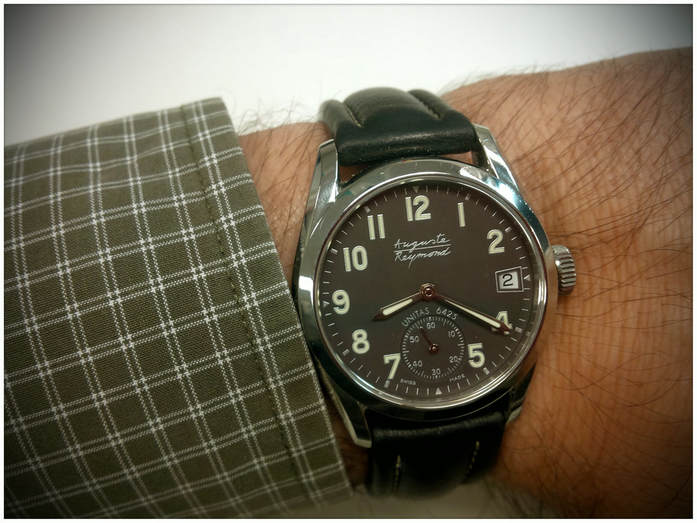 For more than a century the company ‘AUGUSTE REYMOND’ has manufactured watches in Tramelan, a village located in the Jura Mountains, the very heart of the Swiss Watch Valley. Few people know that the Auguste Reymond factory gave birth to today’s ubiquitous UNITAS line of sturdy pocket watches & movements. This family owned company manufactures hand-assembled watches in small series made by highly experienced watchmakers in the company’s own workshops in Tramelan. Unfortunately horizontal integration in the Swiss Jura Mountains led the ARSA 6498 patents straight into the portfolio of ETA factories. However, the Tramelan-based watch factory still produces a smaller calendar-enabled iteration of the hand-wound movement, the UNITAS 6425. Sized at 36 mm, this Auguste Reymond Boogie model is the first instance where the brand uses a movement they created themselves. The UNITAS 6425 is 13 lines wide by 4.6 mm thick. The monometallic balance wheel with Incabloc protection is paced at 21,600 A/h (3 Hz) and runs for 48 hours. This particular August Reymond Boogie model from the early 80’s marks a revival of the UNITAS manual calibre produced in the sixties. When created, this model was fully restored and newly decorated for a limited series of 999 watches and represented a fine tribute to the sober and functional creations for which Auguste Reymond has been famous for more than a century. The movement is a mechanical, UNITAS 6425 calibre with appliqué hour markers, small seconds at 6 o'clock and date window at 3 o'clock. The case is polished stainless steel with sapphire crystal and transparent screw-down back. 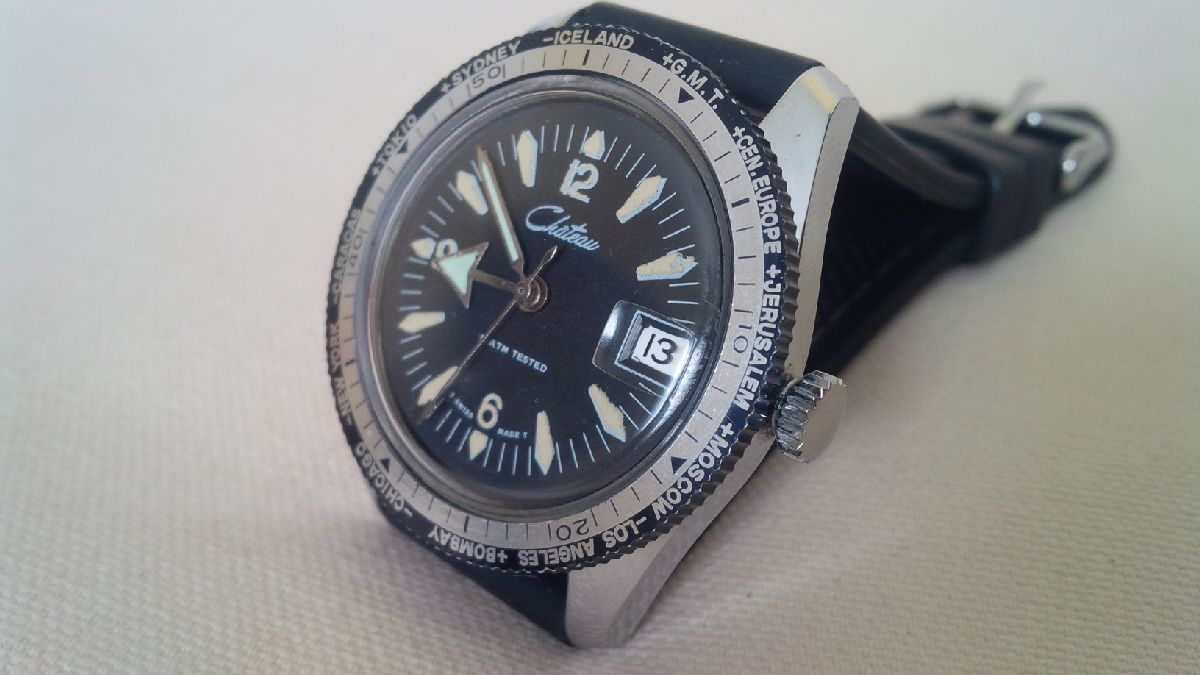 Mystery watch. Beautiful vintage late 60's diver's Chateau watch. It has a Swiss Baumgartner 582 movement wind up 21`600 a/h . Not much is known about this brand. 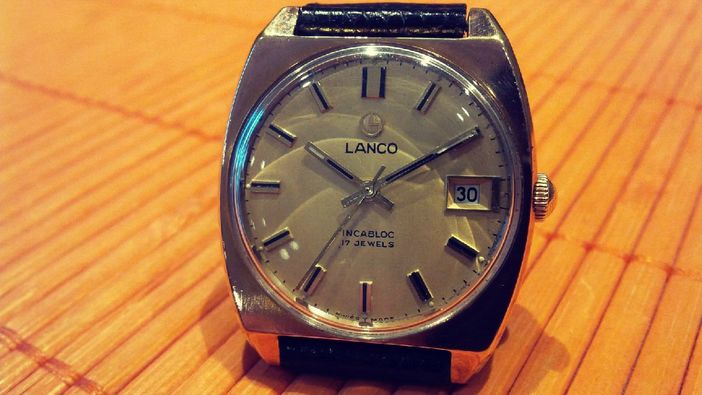 Lanco was the brand name of the Uhrenfabrik Langendorf SA, located in Langendorf, Switzerland, right in the middle of the Solothurn Canton. A certain family Kottmann from Solothurn (Langendorf isn't far) set up industrial production in 1842 there, and in 1873 a chicory factory was rebuilt to make ebauche for other companies, using between 70 and 80 workers. However, the company did not do well and almost collapsed in 1880. In the middle of 1880, just before the company would have been liquidated, Kottmann was able to import specialists from western Switzerland, who were able to turn the company around. In 1902, Ernst Kottmann (1874–1944) became manager of the company which he led until 1942 when he had to resign due to health reasons. His brother Rudolf Kottmann held the position until 1964. Hans Kottmann took over in 1964, but died the same year in an accident. The company was then led by Guido Kottmann and a committee of family members, but due to challenging business conditions – and perhaps problems of mismanagement – the company decided to join a conglomerate of watch makers called "Schweizerischen Gesellschaft für Uhrenindustrie AG" (SGU) in 1964. Soon after, in 1965, Langendorf Watch Company is bought by "Société Suisse pour l'Industrie Horlogère SA" (SSIH) which was itself the result of a 1930 merger between Omega and Tissot. Along with Langendorf Watch Company, SSIH acquired more than fifty of its competitors fueled by its new-found commercial success. Although SSIH was Switzerland’s largest and the world's third largest producer of watches, the company suffered due to heavy competition. It went on to merge with ASUAG into SSIH/ASUAG Holding Company in 1983 – which was renamed SMH in 1986 and in 1988 became The Swatch Group. The company started using the name “Lanco” (for Langendorf Company) sometime in the 1960s. Langendorf Watch Company was attractive for the Lanco brand and its highly sophisticated and semi-automated production line with modern manufacturing equipment. With the acquisition, SSIH managed to broaden its product range and got the machinery needed to produce quality products at a lower cost than before. In 1973, production was ceased at the Langendorf production facilities, and the Lanco brand was relegated to the Aetos Watch Company, another sub-branch of SSIH. Since 1977, the old factory building in Langendorf has been a shopping centre. 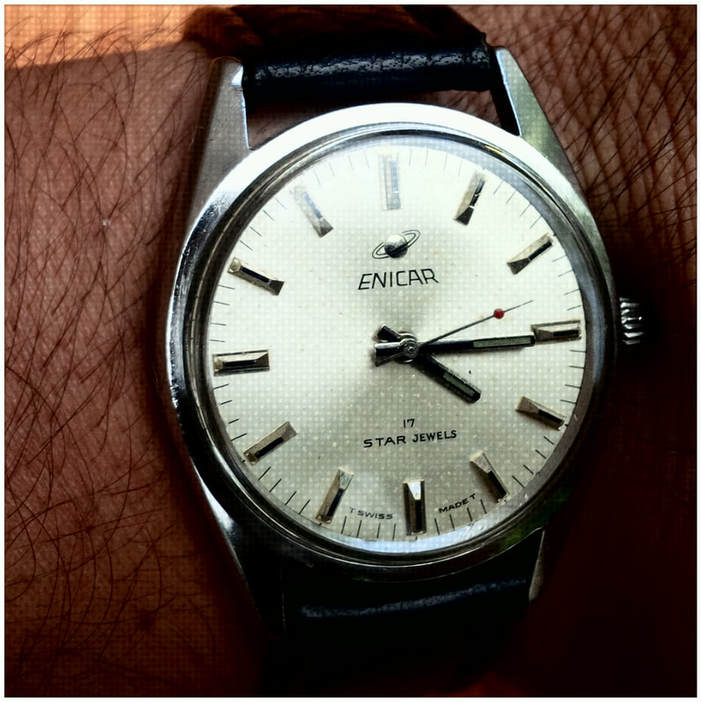 The Racine family was well-known in watchmaking as early as the 1700's. There were many watchmaking businesses with a Racine family member involved, though only a few actually used the family name. One, Jules Racine Sr., had registered the family name as a watch brand. Therefore, when Ariste Racine and his wife Emma Blatt began their Manufacture d'Horlogerie Ariste Racine in La Chaux-de-Fonds in 1913, they were unable to sell watches under their own name. Emma suggested reversing the family name "RACINE", and the "ENICAR" brand was born and registered on January 6, 1914. Nearly all of the products of the Ariste Racine company used the Enicar name by the 1920's, though they also held trademarks on Alprosa, Chromicar, Chrono M, Etsira, Longeau, Savillon, Swisbaby, Swisboy, Sykos, and Teddy. The company became a Société Anonyme in 1932 and took on the name of their main brand, Enicar S.A. It remained a family firm, however, with the children and cousins taking control once Ariste and Emma left in 1943. After World War II, under the leadership of Ariste Racine, Jr., Enicar modernized and expanded production. The company boasted that their movements were cleaned in a laboratory, leading to the Ultrasonic brand found on many watches in the 1950's and 1960's. The company had begun producing their own movements by then, with as many as 70,000 produced annually in the early 1950's. Their movements were quite accurate as well, with Calibre 1010 winning chronometer certification by the Neuchâtel Observatory for the first time in 1954. Enicar also developed a water-resistant case with an unusual bayonet back, introducing it as the Sea pearl in 1955. Enicar's own automatic movement, Calibre 1125 appeared in 1959. Over 100 different Enicar Sherpa watches were introduced in the following decade, becoming their most famous brand. Enicar also proved the ruggedness of their watches by attaching a Sherpa Ocean Pearl to the keel of the sailing ship Mayflower II as it crossed the Atlantic in 1957. This led to the creation of a family of Sherpa Dive watches. Many Sherpa watches were re branded with the "Star" name in the 1960's as Enicar modernized their designs. But the quartz crisis was not kind to Enicar, which was not absorbed into the Swiss conglomerates that became "Swatch Group". On November 13, 1987, Enicar was declared insolvent. 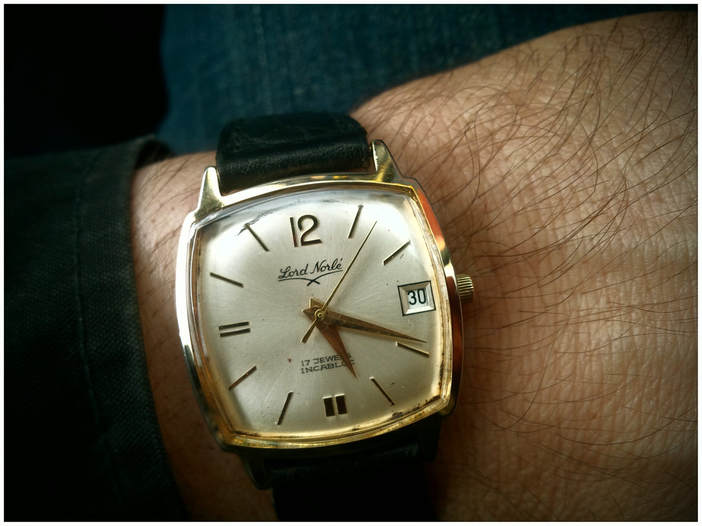 Mystery watch. Not much is known about this brand and information is very scarce. The only reference related to this brand is this: "On Wednesday, April 20, 1966, a Canadian Trademark Registration was filed for LORD NORLÉ by NORMAN ASTROFF, TRADING AS 'NORLE LTD'. 400 Ontario Street West, Montreal, QUEBEC, CANADA . The Canadian IP office has given the trademark application number of 296460. The current status of this trademark filing is "Registration Cancelled". The LORD NORLÉ trademark was filed in the description of 'Watches'. 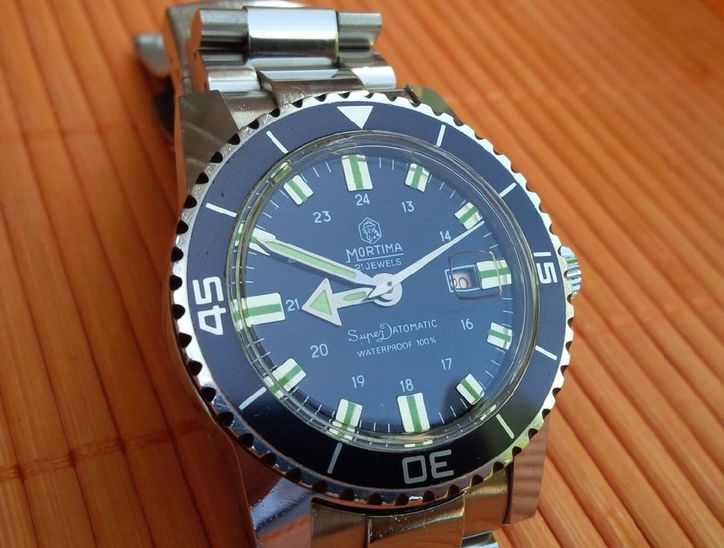 The history of Mortima watches: 'Établissements Cattin’ and their main brand Mortima was founded in 1926, by Emile Cattin (1904 - 1979) in Morteau, Doubs region of France. The production of the 20's to early 40's, seems to have used third-party movements in what were regarded as basic "working mans" watches. The watches were mainly sold by leaflets, in markets and fairgrounds. By the end of the 1930's, Cattin was producing over 30,000 watches a year. He had around 90 employees, a good few of which were outworkers. With the success of Mortima, Emile Cattin bought a hotel in 1939 to expand the watch manufacturing business the l'Hotel de Terrasses on the rue d'Helvétie in Morteau. However, timing turned out to be bad, due to World War II starting that very same year. Mortima takes market shares and goes international: After the war, in 1947 Cattin decided to take the business to another level. In conjunction with Martial Vuillemin they converted the hotel into a factory, producing watches and their in house movement 'Cattin 66' (C66). The Roskopf based pin-lever C66 movements were made in many variants. Movements with 1, 15, 17 and 21 jewels were made. At the same time Cattin also opened a workshop to produce watch faces, all bearing the already well known French Cockerel logo. Now almost all components of the Mortima watch were manufactured in-house. To capture the international market, Cattin established a Paris office in 1954. Customers from all over the world came to buy watches directly from the office. Export was now the main market, with large sales to French colonies in Caribbean and Africa. At the peak of success: The company was now producing thousands of watches every day. Cattin made generous contributions to the local community, and opened a Horological Factory School for the disabled. In 1960 he was awarded the French l'Oscar de l'Exportation by the French government. After receiving the reward Émile Cattin held a grand ball in the town hall of Montreu, inviting all employees to celebrate the occasion. Cattin was attentive to his employees. He wanted the workers to be proud of working in the company, giving them many benefits not common at the time. In 1961 the company had outgrown their manufacturing facilities, producing upwards of 2 million watches each year. Two years later a new factory was opened in the same area, la Guron. Export which truly gained momentum with the launch of the C64 movement for women watches in 1964, and a slim version of the C66. Upwards of 10,000 watches per day came out of the factory assembly line. At the same time it was not uncommon that one single customer, at the Paris office, would walk away with the same amount of watches. The end of an era: Emile Cattin died in 1979, and his children took over the company. Two of them died in 1982. His son and company manager died in a car accident in 1985. The company made three quartz movements during the 1980’s. Quartz movements C80, C81 and C86. But without the visionary Emile Cattin, and several family tragedies, the company failed to keep up with the quartz revolution like many other French and Swiss watch makers at the time. The Paris office was closed in 1987, and the company was sold to Kiplé in 1988. Huge financial problems led to bankruptcy of Kiplé in 1990, ending the story of Mortima watches. Cattin is still highly regarded in Morteau, to the extent that he, alongside such notables as General De Gaulle, Albert Camus and Louis Pasteur, has an important road in the town named after him. 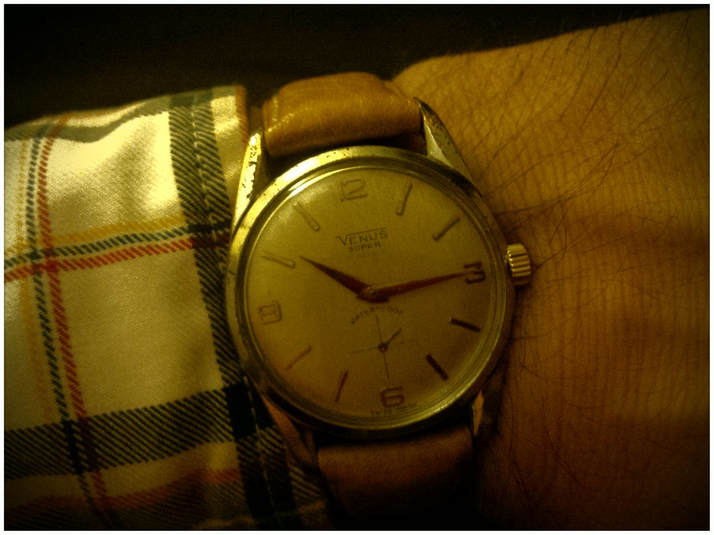 In 1902 at the very heart of the Swiss watchmaking industry, in a village named La Chaux-de-Fonds, a master craftsman by the name of Paul Arthur Schwarz and his wife Olga Etienne-Schwarz, two visionary watchmakers, launched one of their very first collections: The VENUS collection. It was immediately noted for its elegance and refinement. The values expressed by the brand quickly became synonymous with innovative design and manufacturing achievement. By the 1930’s VENUS had begun manufacturing chronograph calibres, which are still being used by many other brands today. It launched numerous lines of extremely successful collections worldwide. The pursuit of this path in innovation and elegance culminated in Venus historically achieving international acclaim at the Basel fair of 1950 by winning 1st prize for one of its attractive designs. The 1960s saw the company organising glamorous events, such as in Athens in 1966, chosen to highlight Greece’s mythical connection with the iconic “Venus de Milo” watch and worn on the occasion by the famous Hollywood actress, Jane Mansfield. At the same time, the watches became so respected that even Leonid Brezhnev, leader of the Soviet Union, wore a VENUS watch on his wrist. Of particular note is an order on behalf of the Vatican: a hundred pieces in white gold, equipped with a mechanical self-winding movement. The decisive moment of VENUS rebirth finally came in 2011. With its headquarters now in cosmopolitan Geneva, VENUS is back in the spotlight. 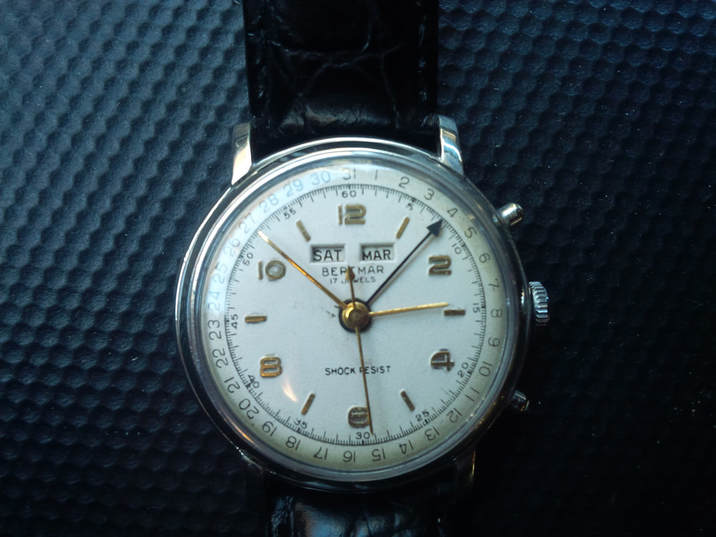 1940's Bertmar triple calendar 17 jewel manual wind watch 1940's Bertmar triple calendar 17 jewel manual wind watch This is a Swiss Made, 1940’s vintage BERTMAR triple calendar watch with day, date, and month display. The blue calendar hand indicates the date. The numbers 1–31 are on the outer track; day and month are displayed in the windows under the 12 o’clock position. This beautiful timepiece measures 32 mm across x 38 mm (lug to lug) which was normal for that period. Not much is know about this brand. For anyone who's interested in this little piece of Canadiana, here’s a brief history of the watch and the company behind it: Research indicates that 'BERTMAR' was the brand name used by the Canadian company “Peoples (Credit) Jewellers”, which started business in Toronto, Ontario Canada early in the 20th century. The brand name was created from the names of founder Frank Gerstein's two sons BERTrand and MARvin. Switzerland was the source for BERTMAR watch movements and cases which were sold in Canada. After Frank Gerstein’s passing, Bertrand and Marvin took over the company and expanded it all across Canada. Watch calendar: To set up this triple calendar watch is a bit tricky. You have to turn the hands well past midnight (say 6:30 am), it is important to be sure that the gears that change the date are completely disengaged to avoid damaging the mechanism. There are two pin push setting points on the right side of the watch, above and below the winding crown, the top one is for the month and the lower one for the date. To change the day the hands must be rotated 24 hours to advance one day. 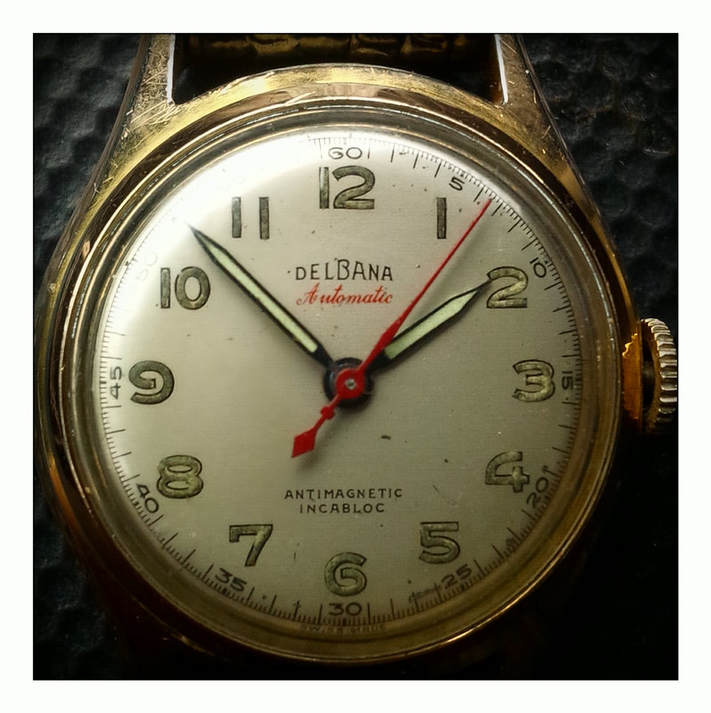 1950's Delbana Automatic, Antimagnetic, Incabloc 1950's Delbana Automatic, Antimagnetic, Incabloc In the early 1920s, a young man by the name of Goliardo Della Balda ventured away from the hilltop enclave of San Marino with his family to create a new life in Switzerland, where he later challenged himself to master the intricacies of the watchmaking business in the burgeoning timepiece capital of the world. He had always longed to own a great timepiece, but at the time it seemed like a luxury for someone of his humble beginnings. After devoting several years to the industry, Signore Della Balda realized his dreams of both owning a great watch and establishing a world-class watch company by introducing his own brand in 1931. The launch sparked an 86-year legacy of creating elegant timepieces characterized by the passionate pursuit and delivery of classic affordable luxury. Further enhanced by the style and watchmaking advancements of the 1940s and ‘50s, the company’s long history of watch design has shaped a meaningful foundation for today’s classic brand look. To this day, the line remains attractive to watch wearers who value precision, quality and style while continuing to reflect Della Balda’s earliest seeds of inspiration. In the early days, Delbana specialized in mechanical pocket watches and wristwatches which were assembled in-house under strict quality controls. The broad discovery of the quality and style of Delbana timepieces soon fueled the company’s growth to over 100 employees and a wide network of local suppliers. In the 1950s and ‘60s, Delbana expanded its annual production to more than 100,000 watches that incorporated the popular AS1130 movement, sought-after around the globe for its quality and robustness. The innovation and mass marketing of Quartz movement powered watches in the 1970s had a wide impact on the Swiss watch industry. By the late 1970s, Delbana merged with the WEGA watch company, parlaying a new chapter for the brand with the production of watches with quartz movements. Delbana soon reclaimed its place designing and producing high-quality timepieces at an affordable price that are, to this day, sought after all over the world. Timeline: •1931: The Company was founded in Grenchen by Goliardo Della Balda •1975: After a period of close cooperation with the Wega company, Delbana and Wega merges together •1988: 50 years Company Anniversary •2002: Delbana brand was integrated into the Delma Watch Group in Lengnau •2003: New fashionable Delbana collection for Europe •2005: Worldwide distribution of renewed collection •2007: Successful introduction of new Delbana collection in Middle East •2008: 75 years company / brand anniversary |
Old Time WatchesI enjoy collecting mechanical (manual wind and automatic) and early electric and quartz timepieces. I take great pleasure in researching and writing about the companies and people that created these beautiful watches. PF
Archives
September 2018
|
||||||||||||||||||||||||||||||||||||||||||||||||||||||
